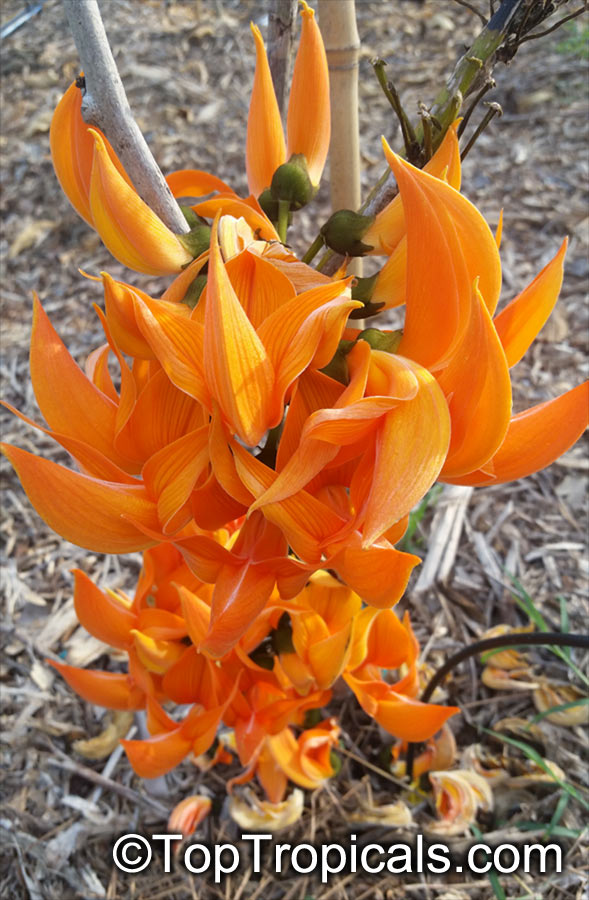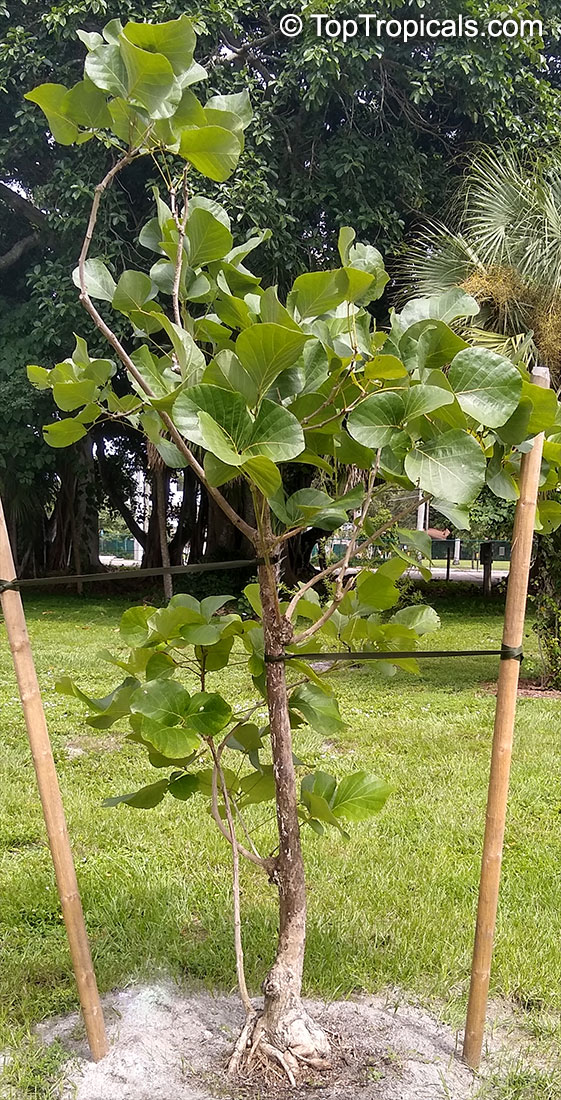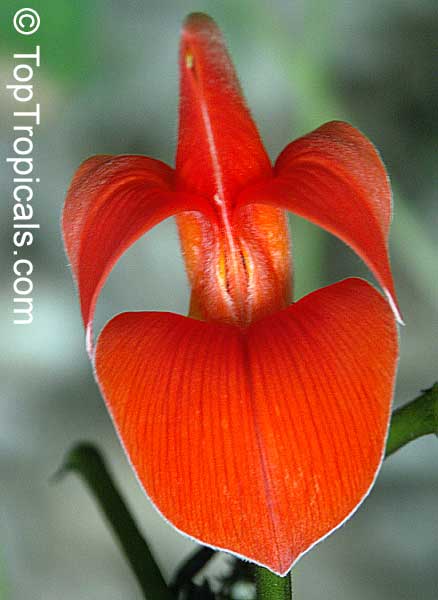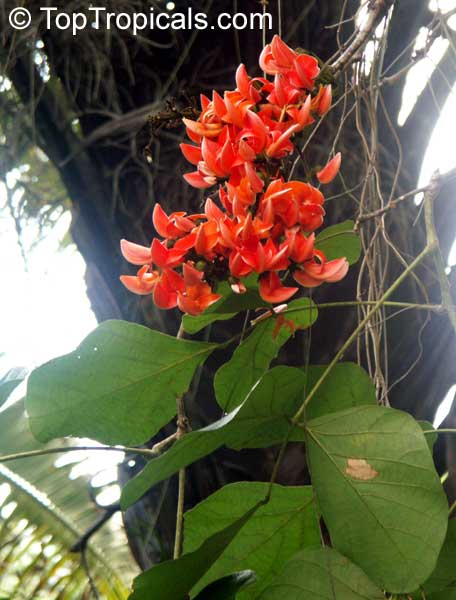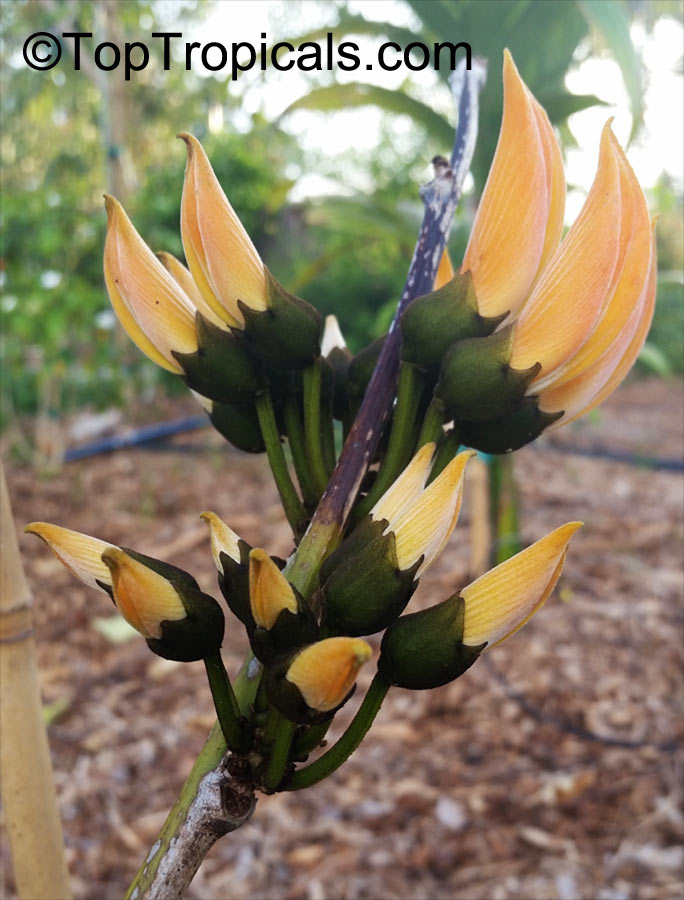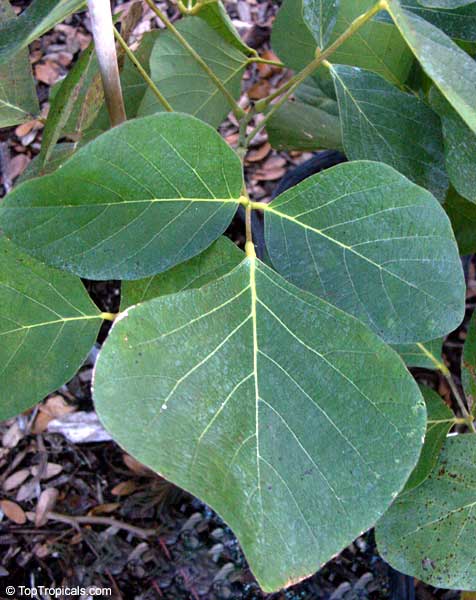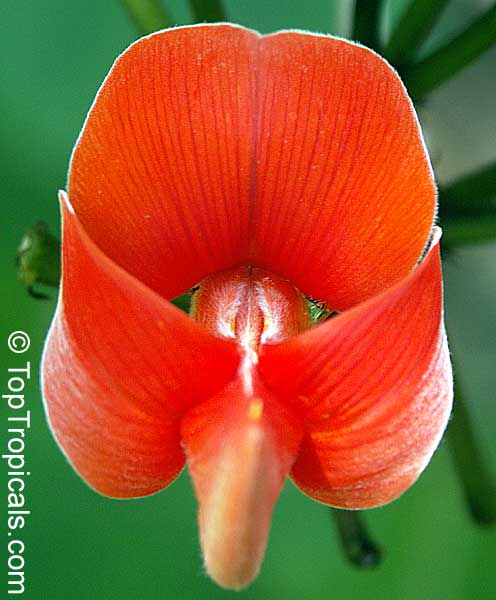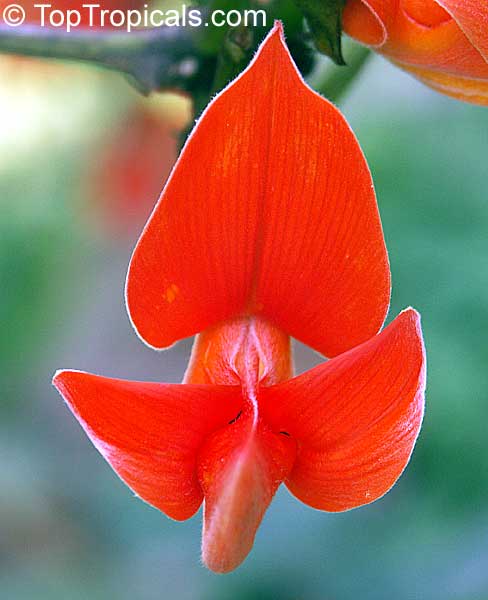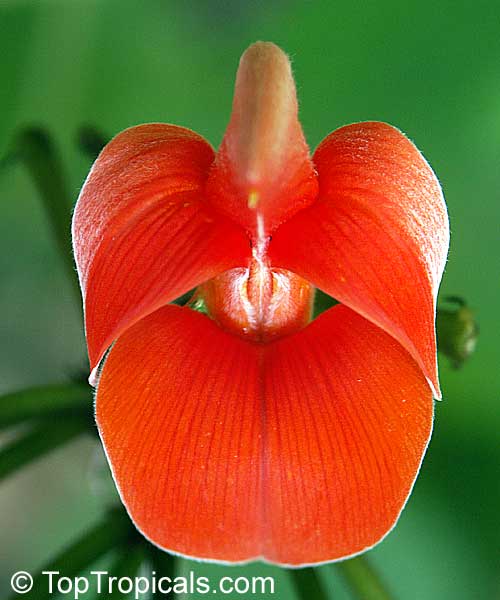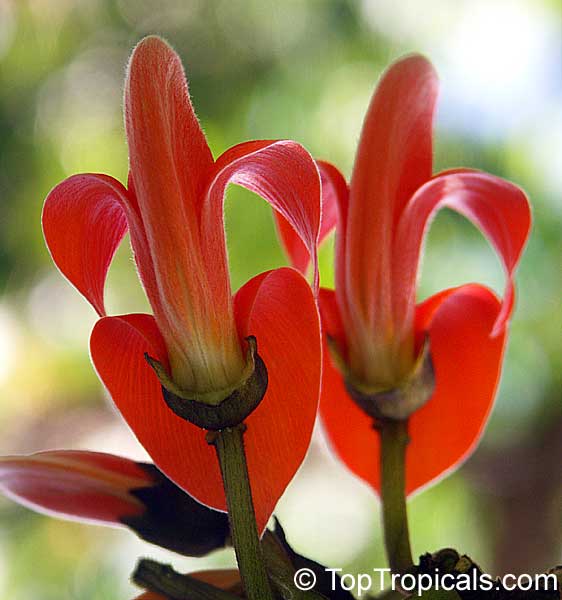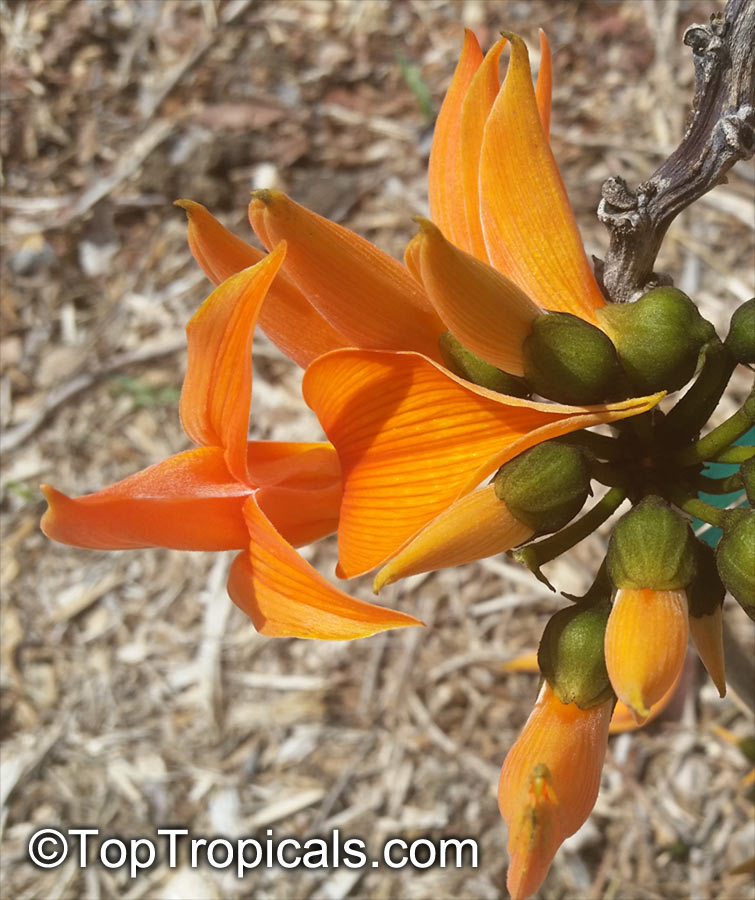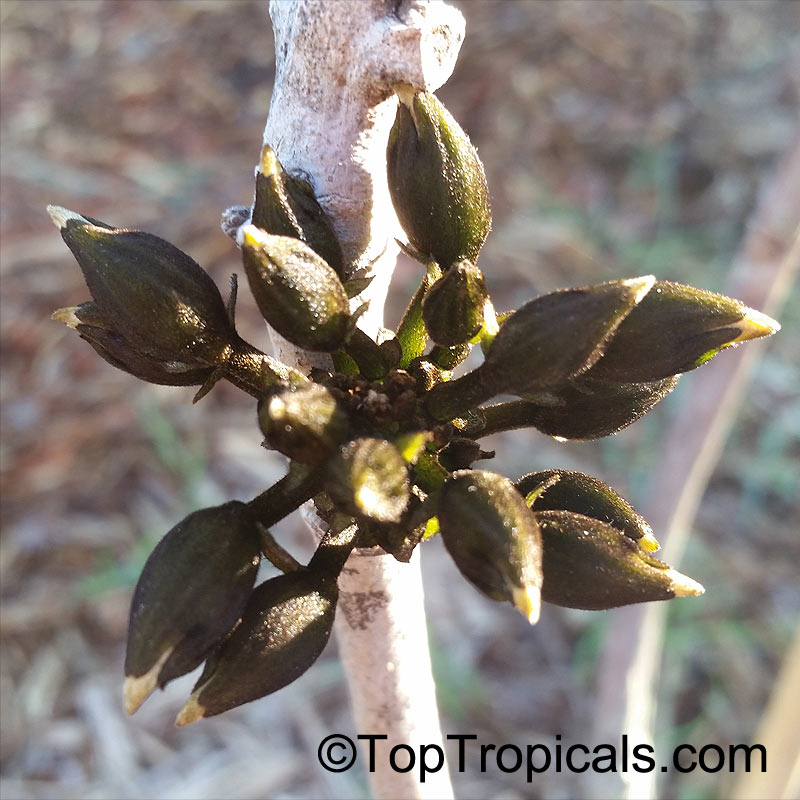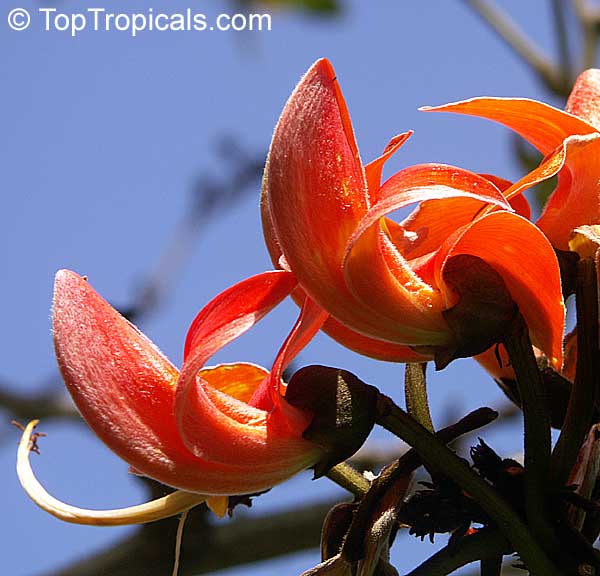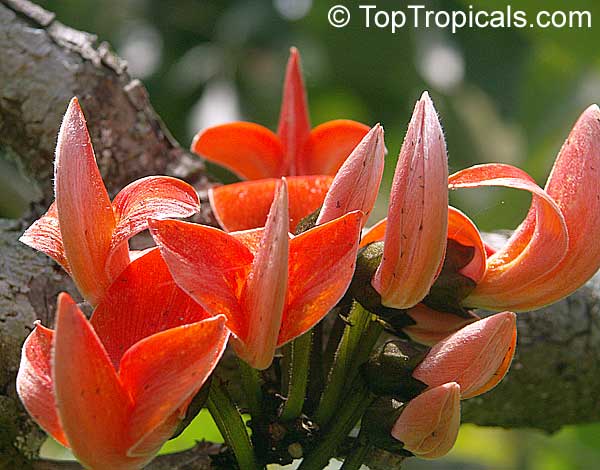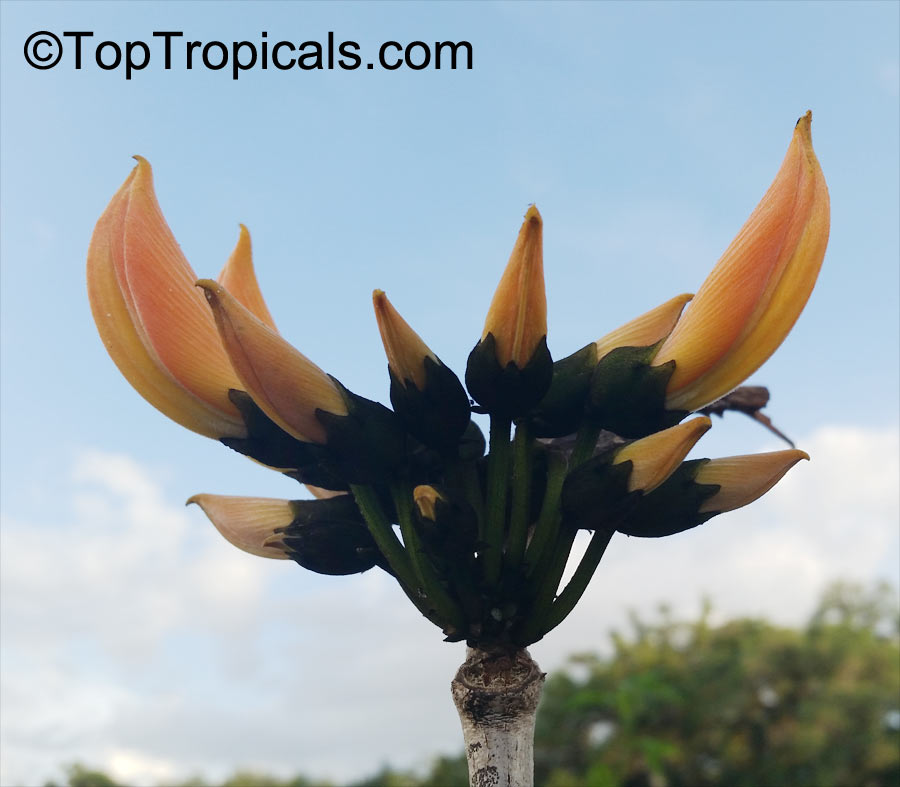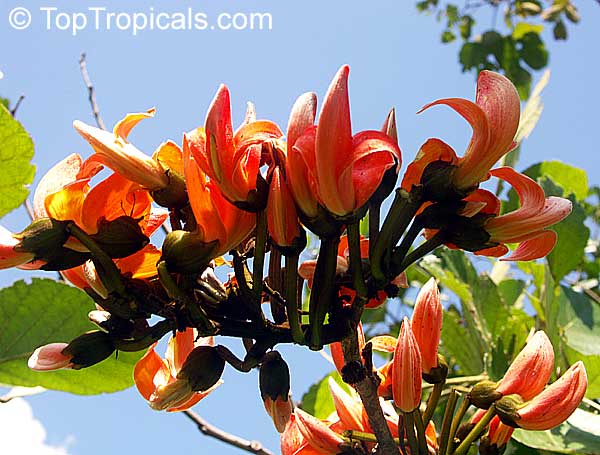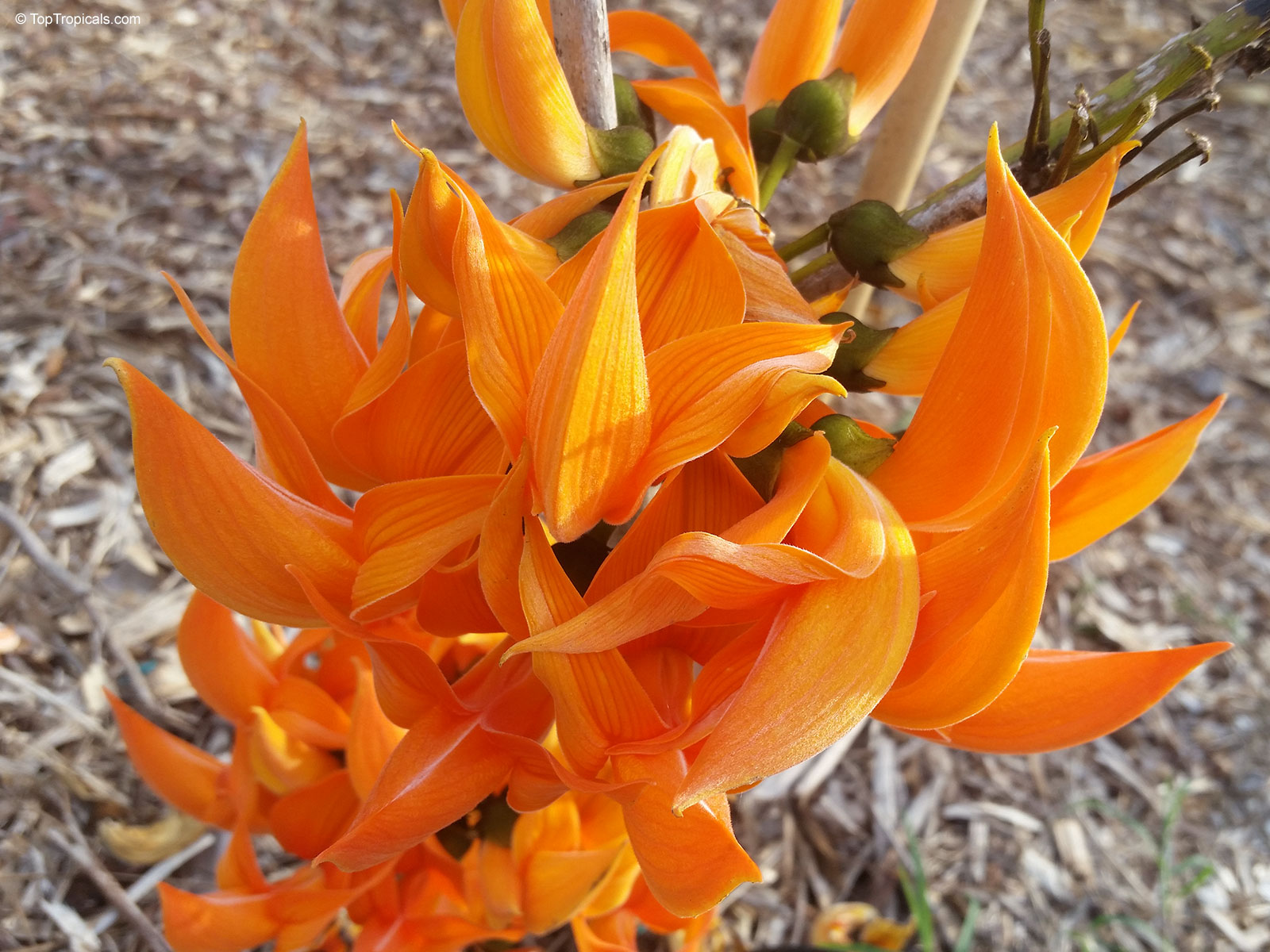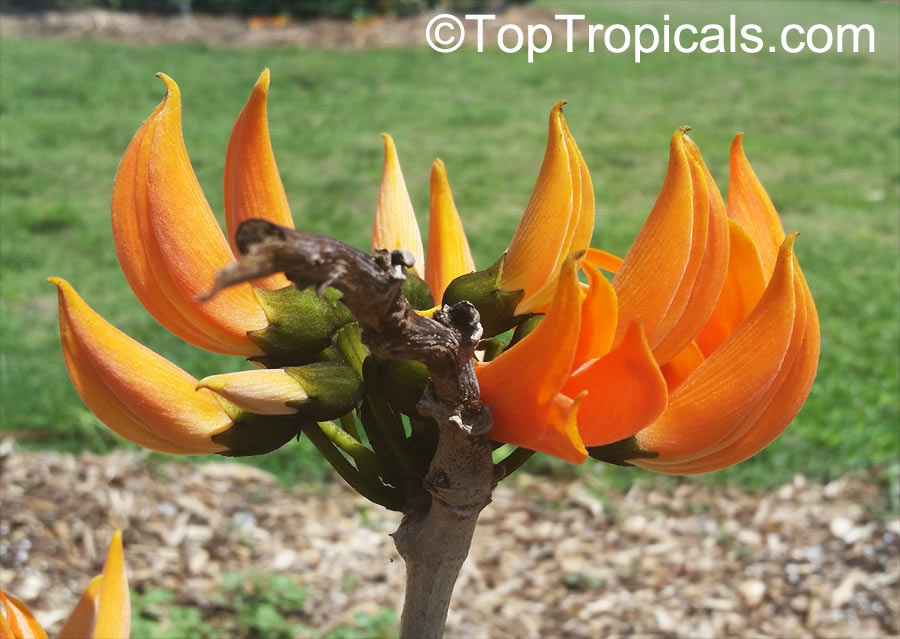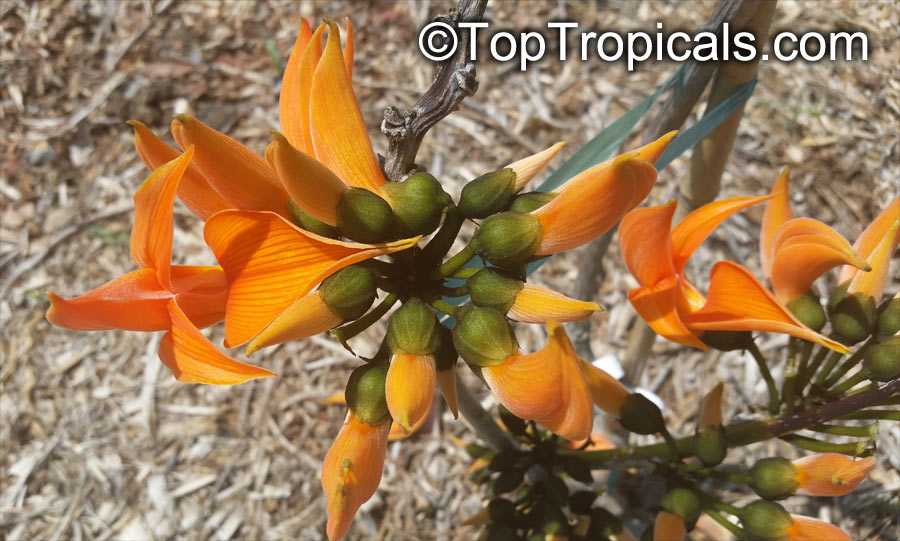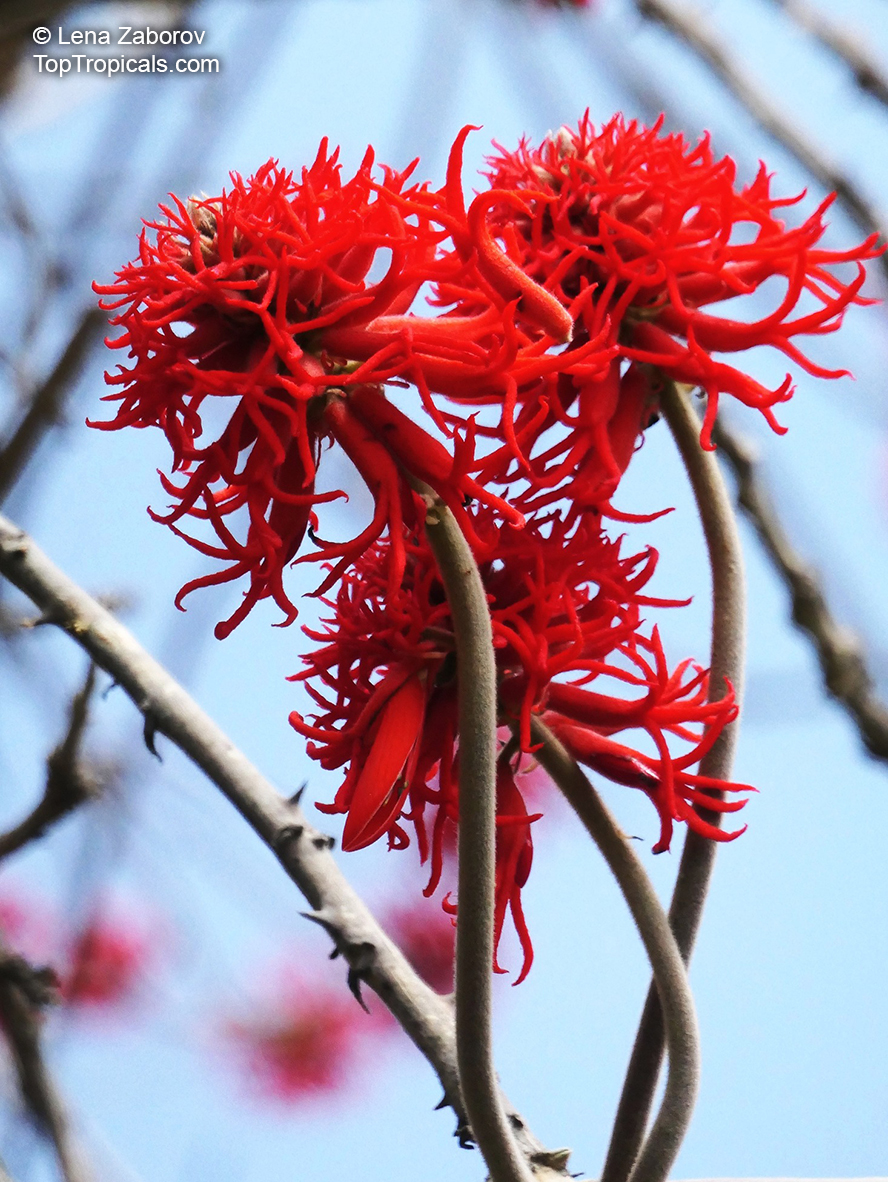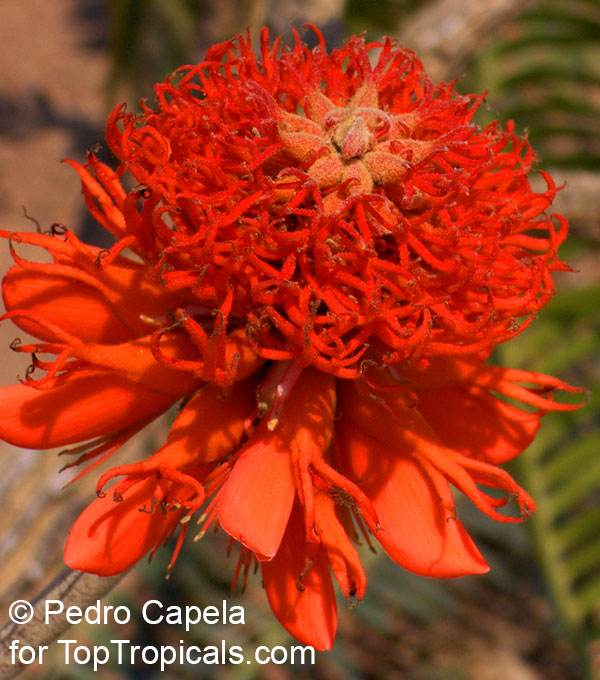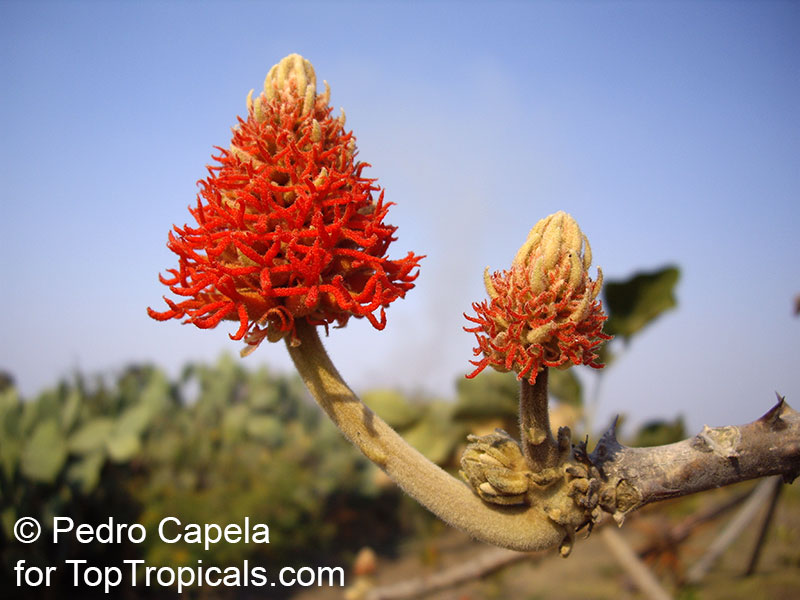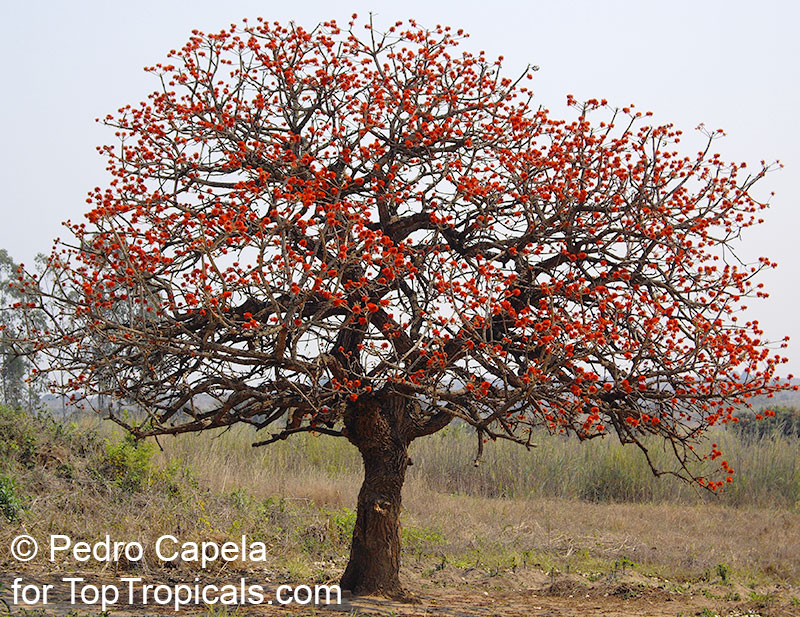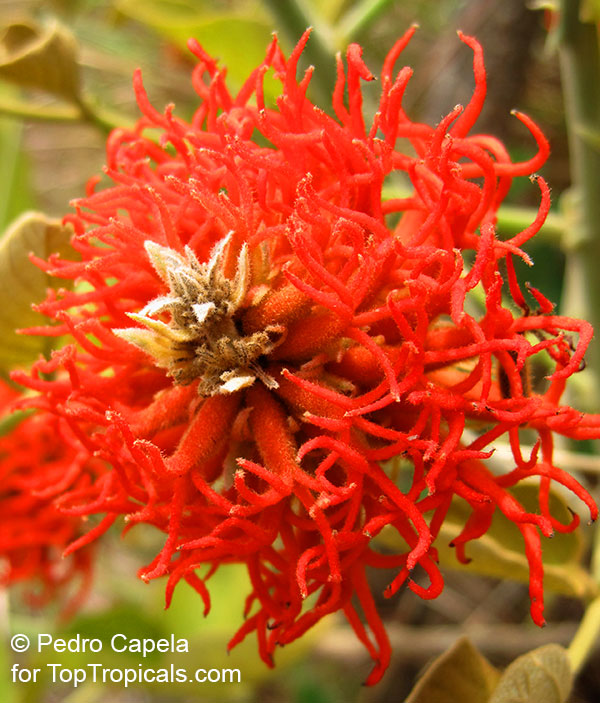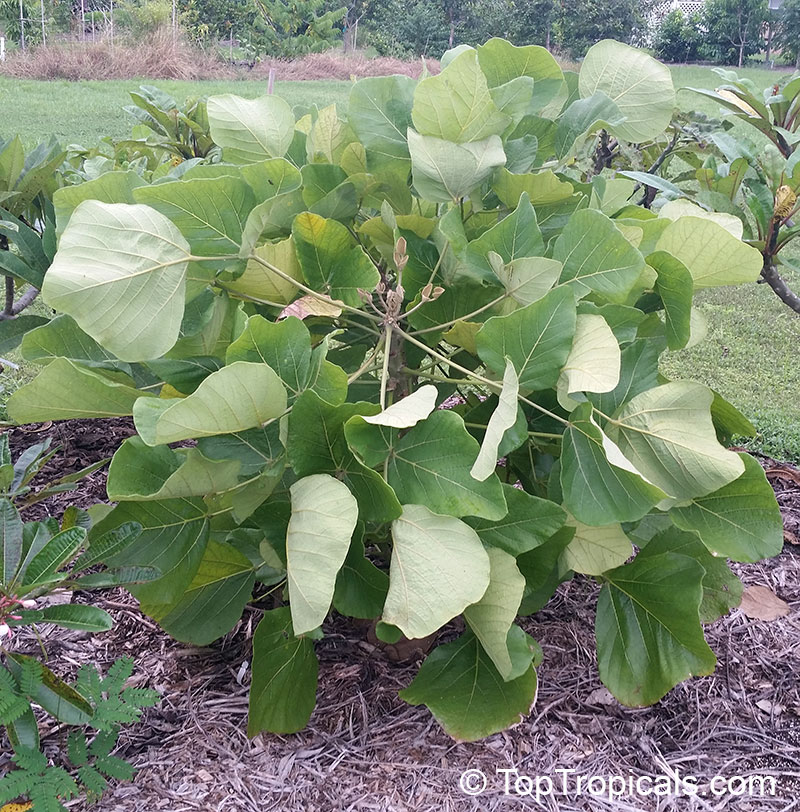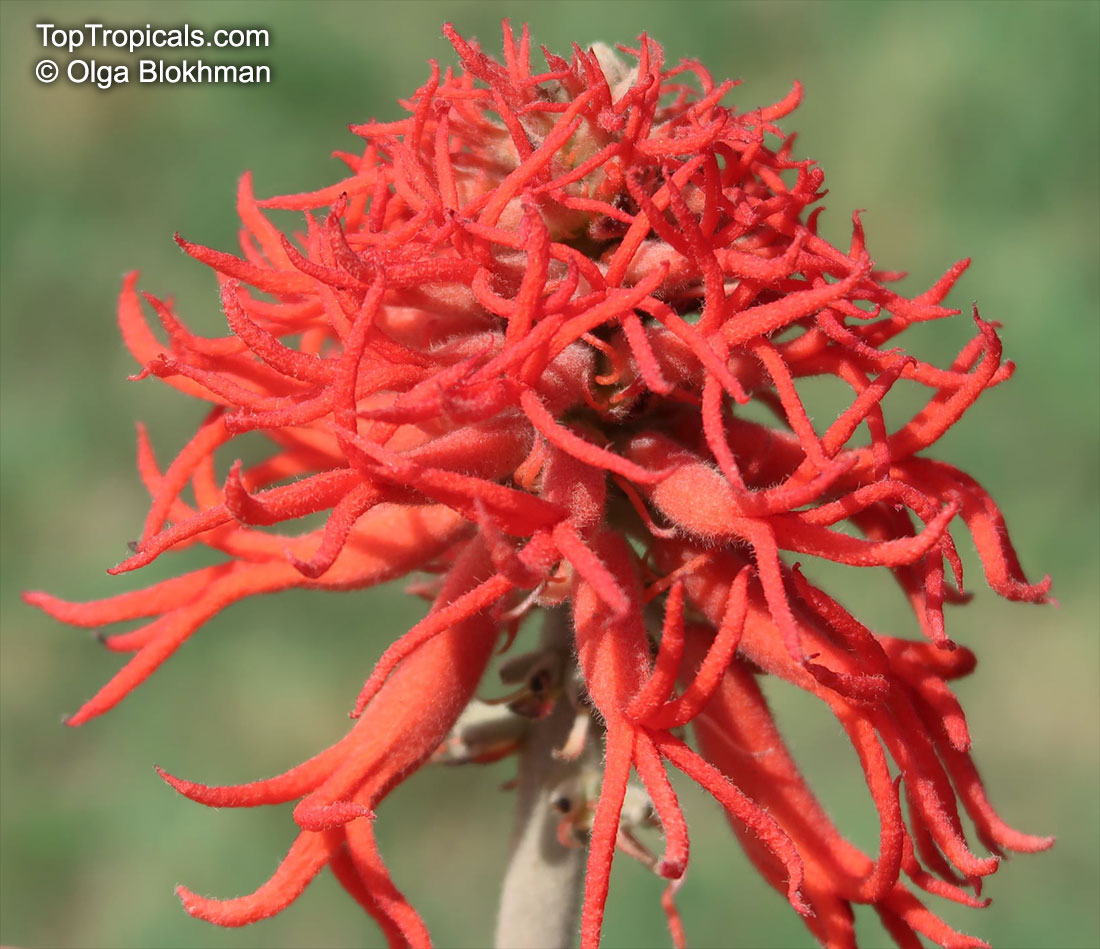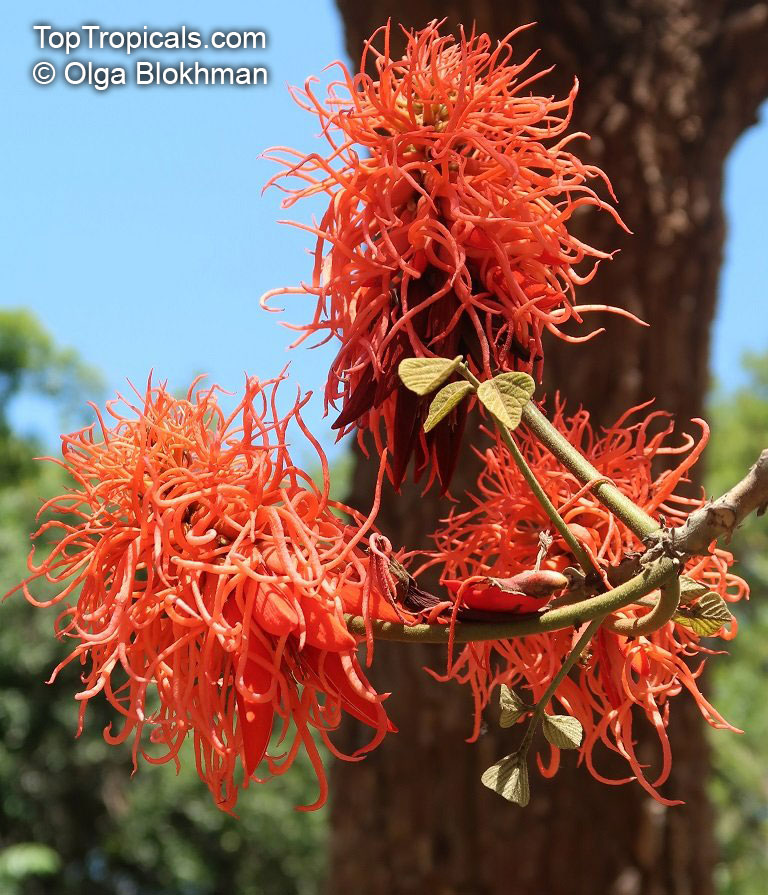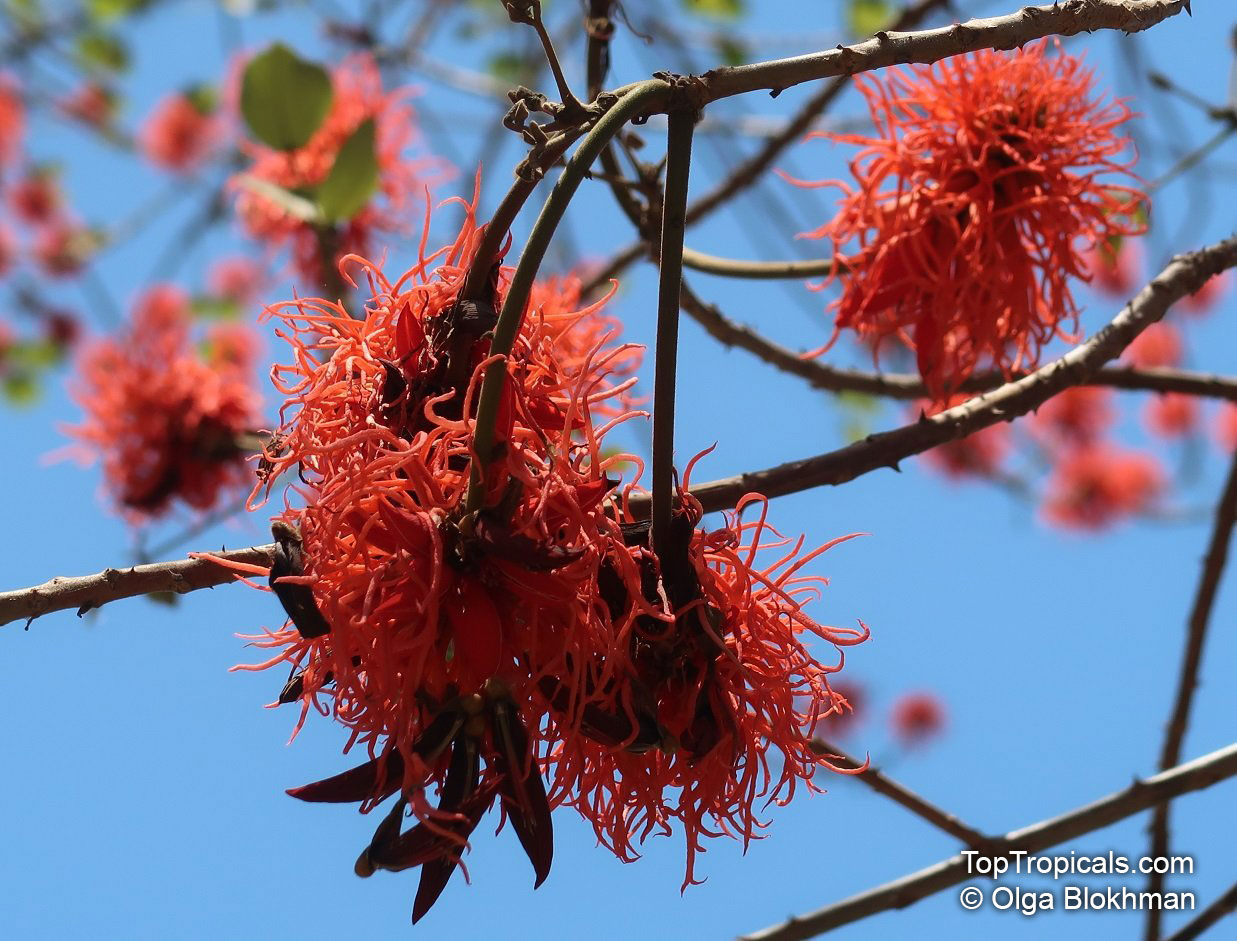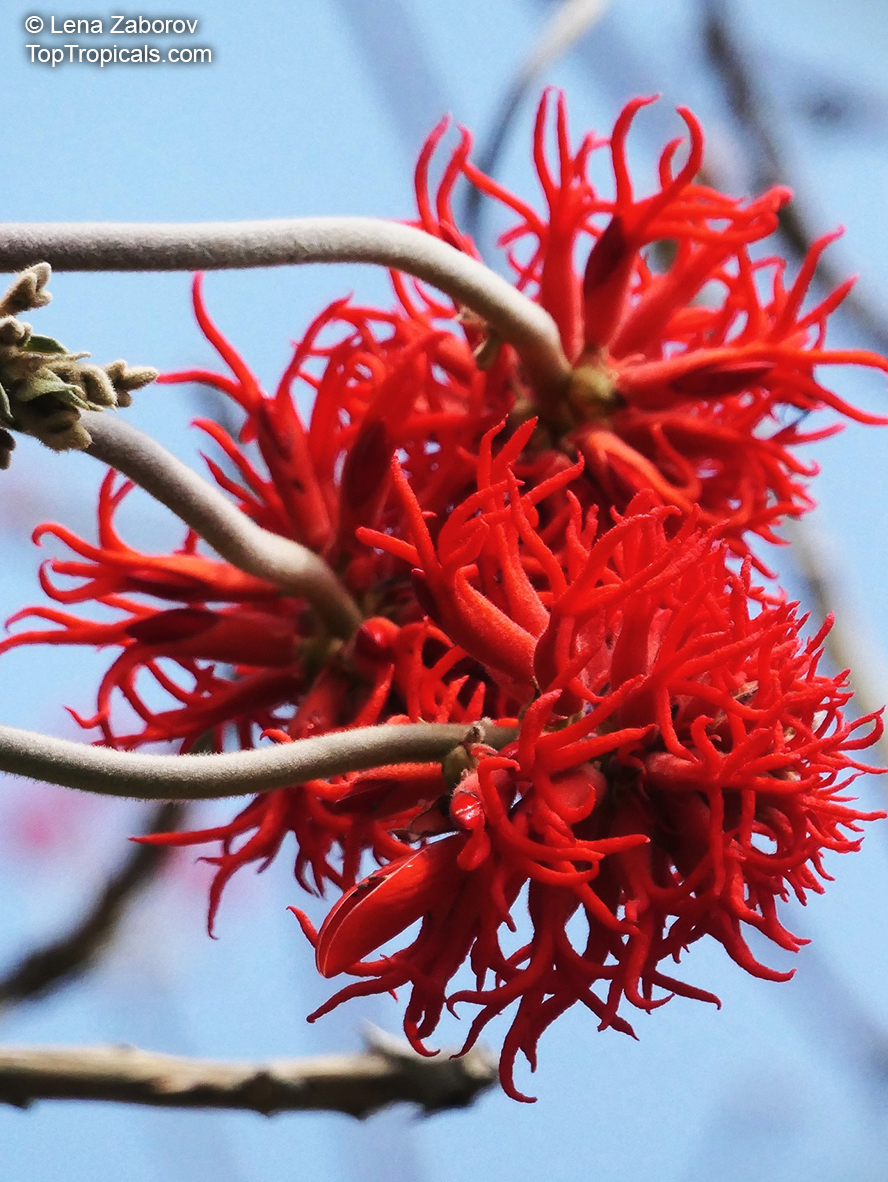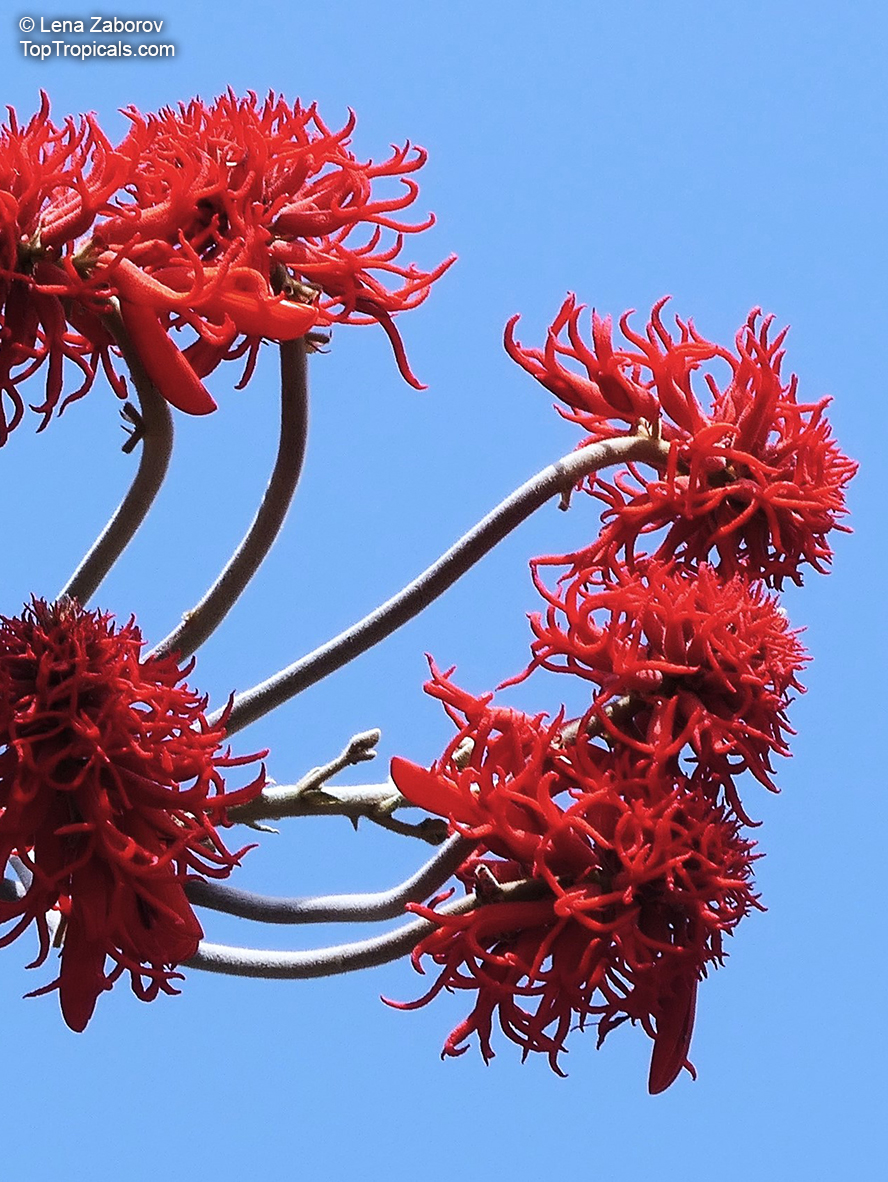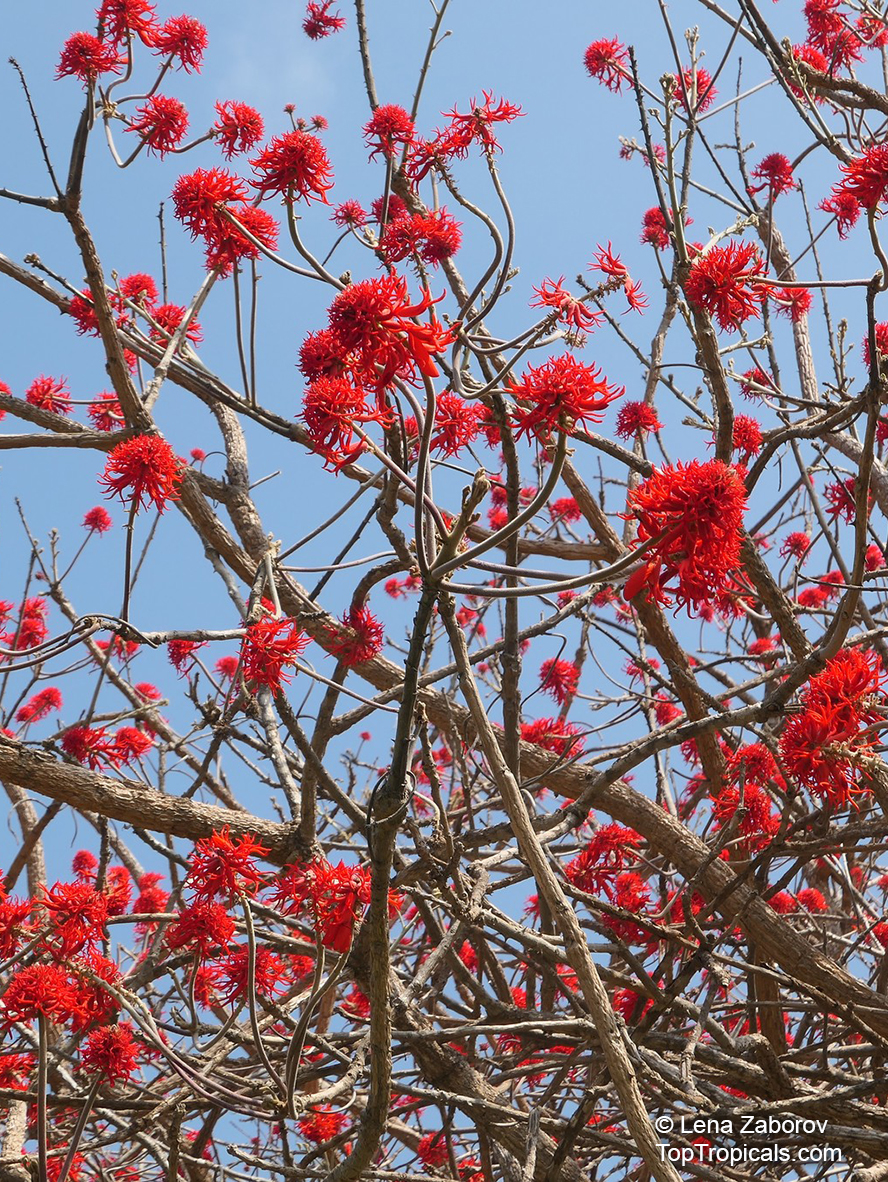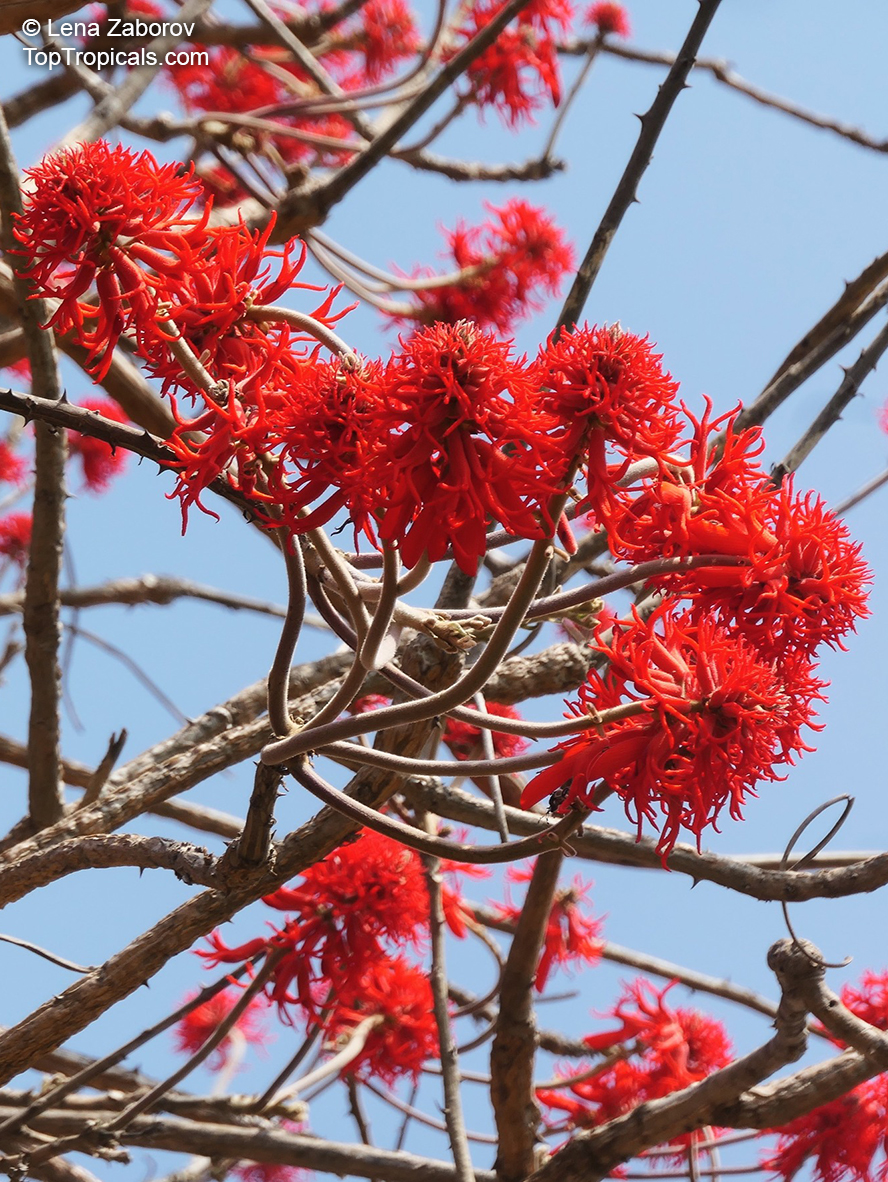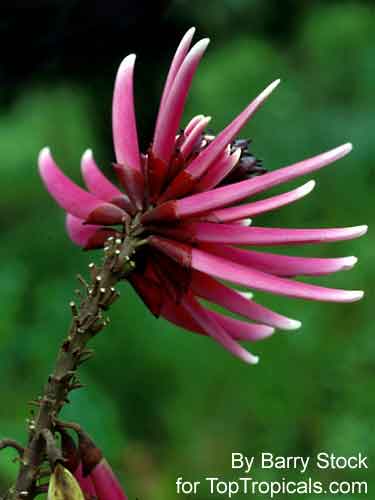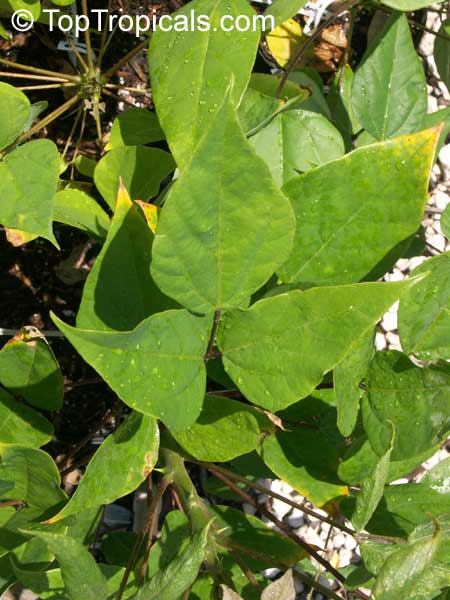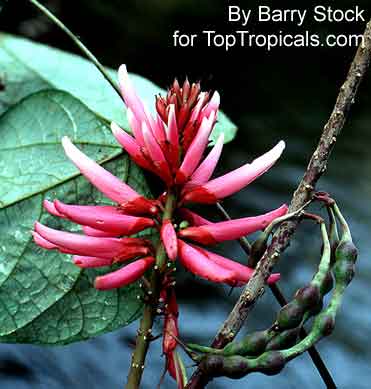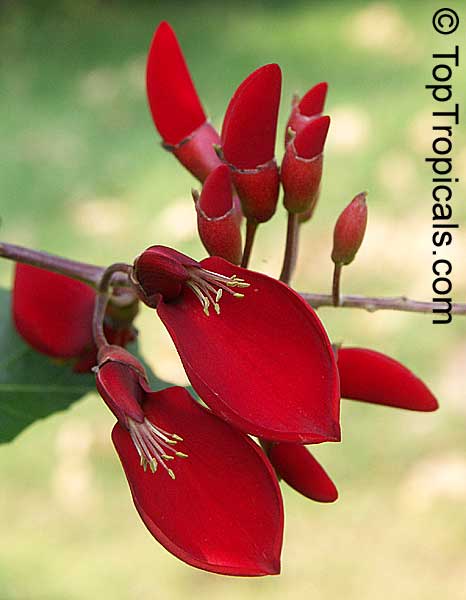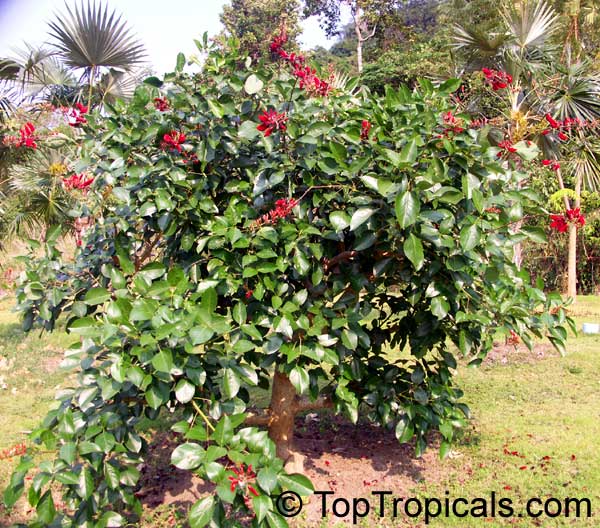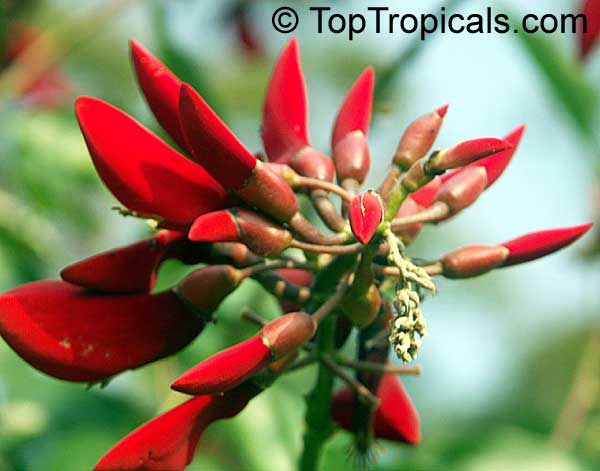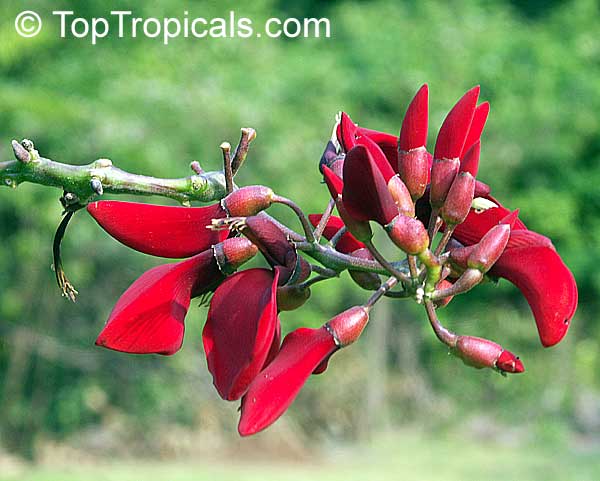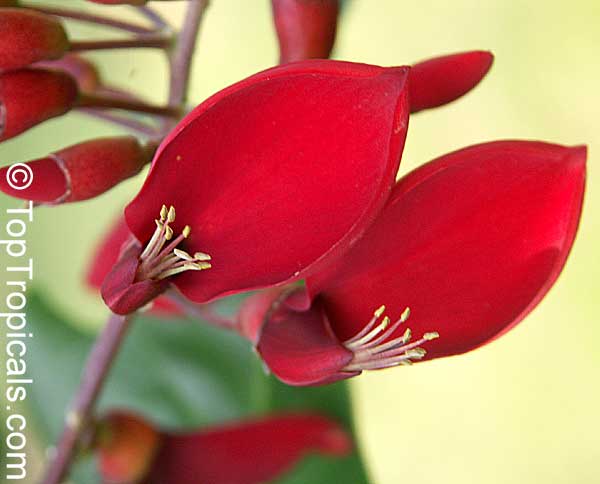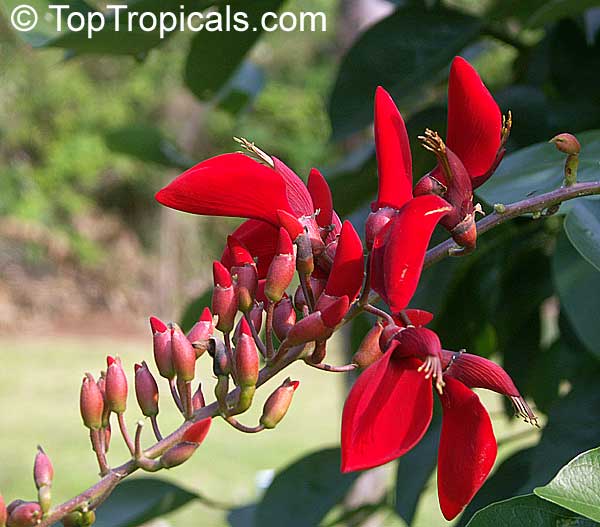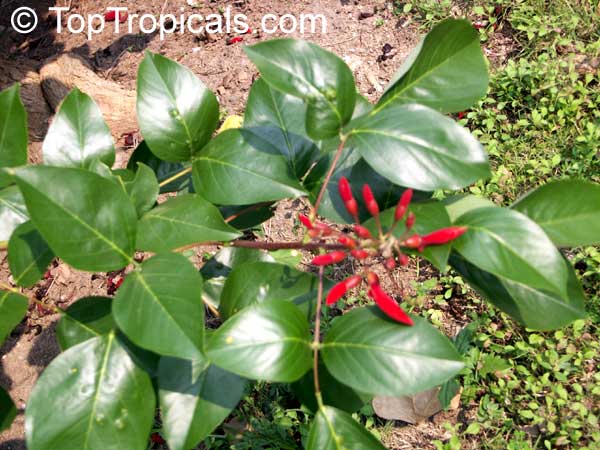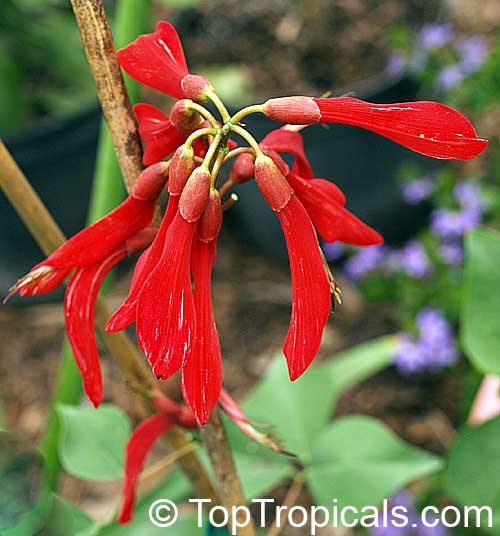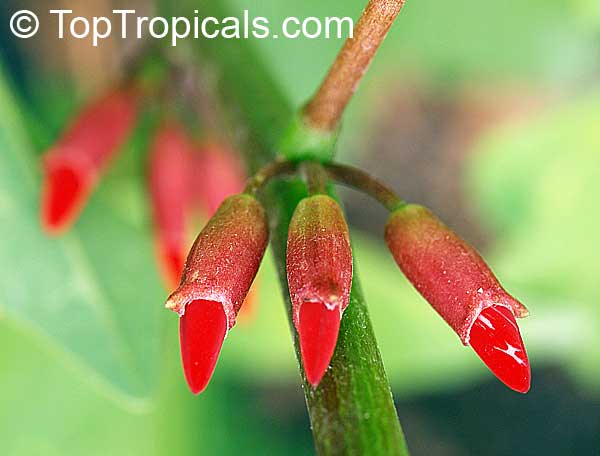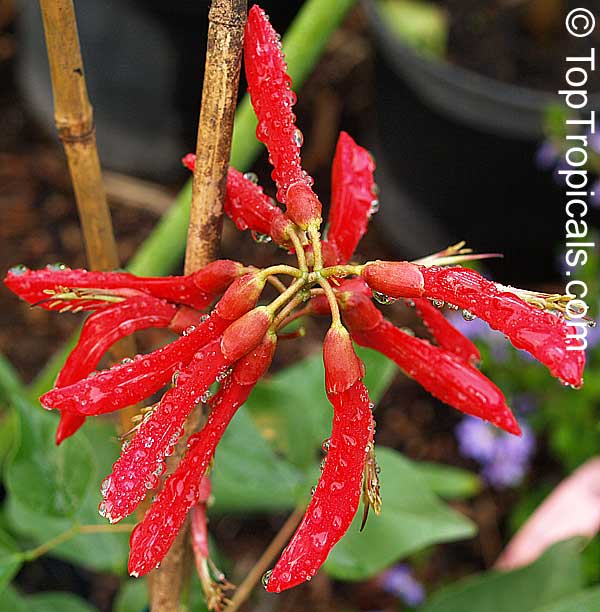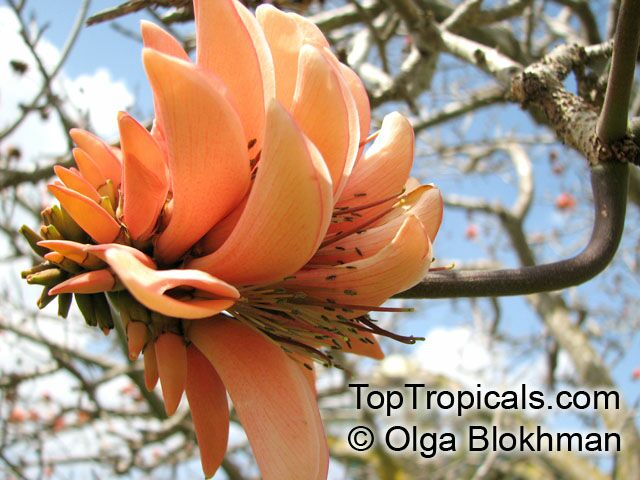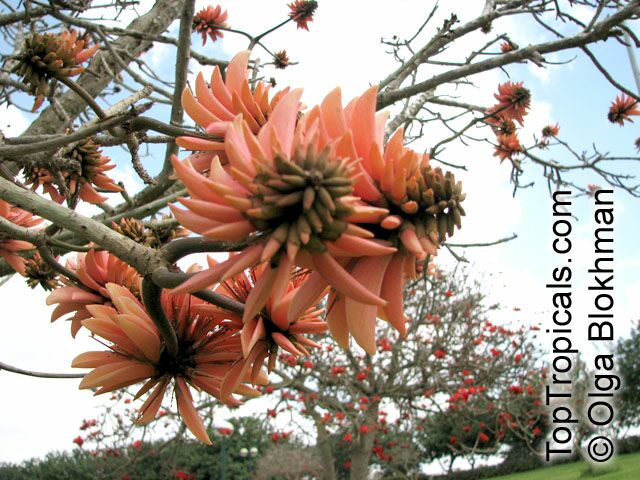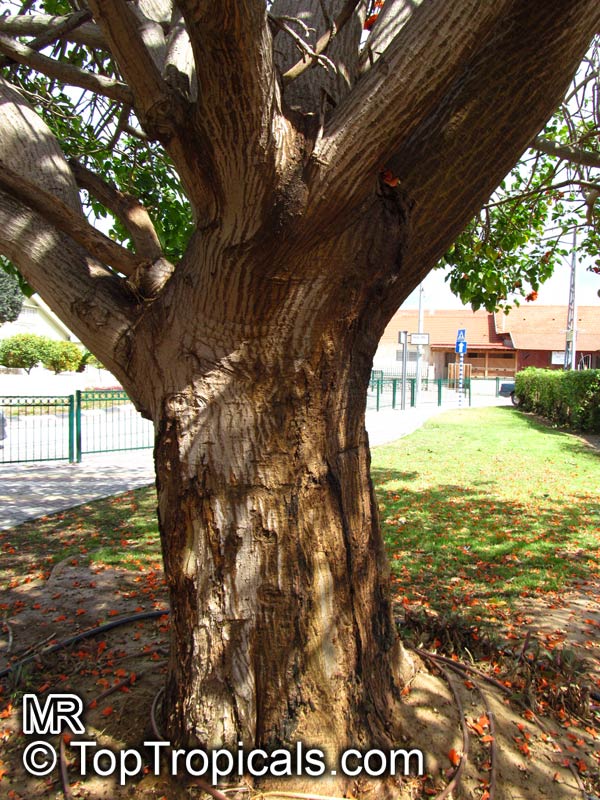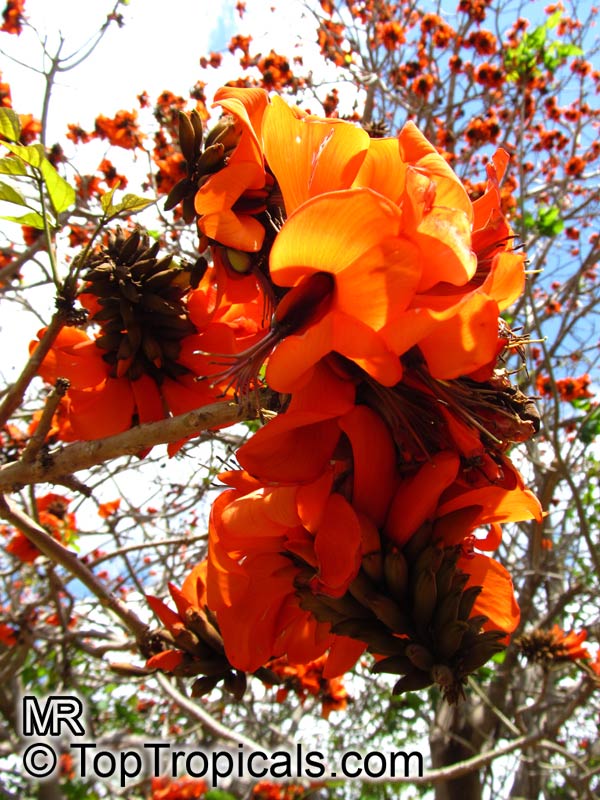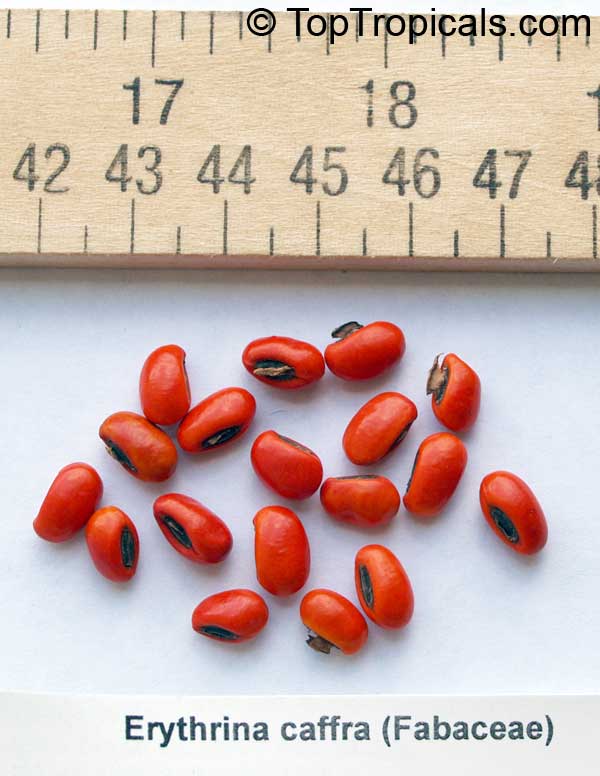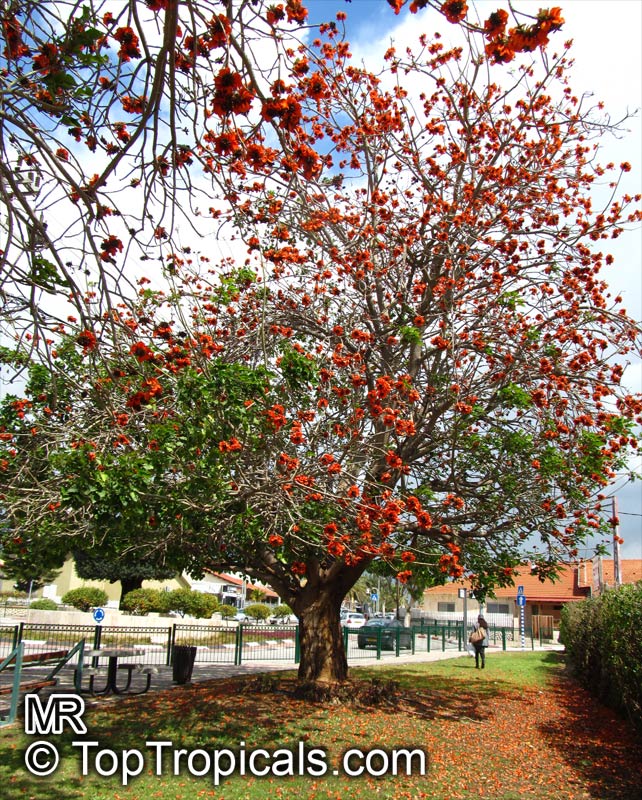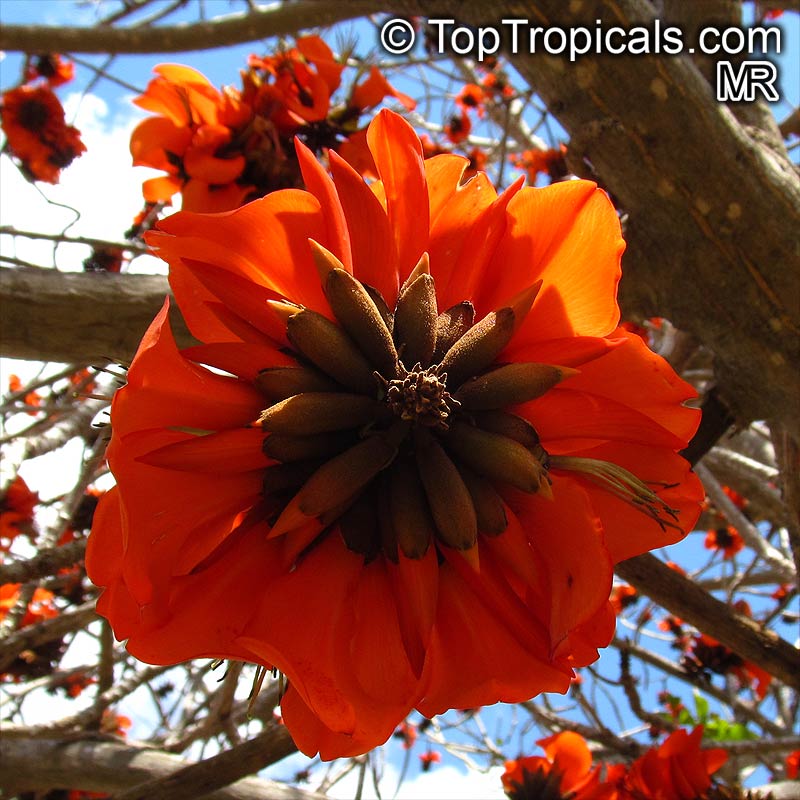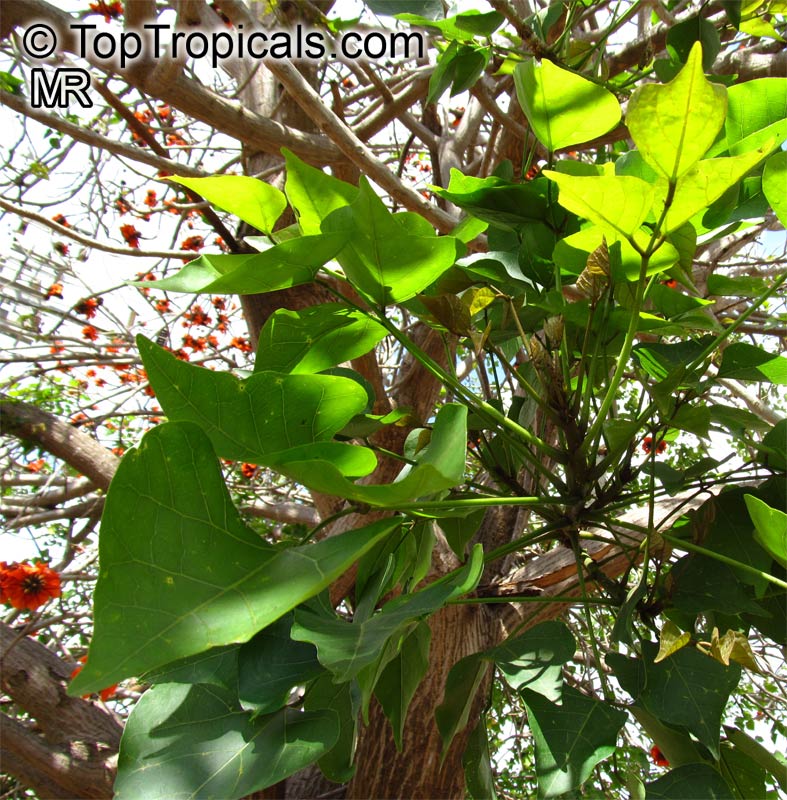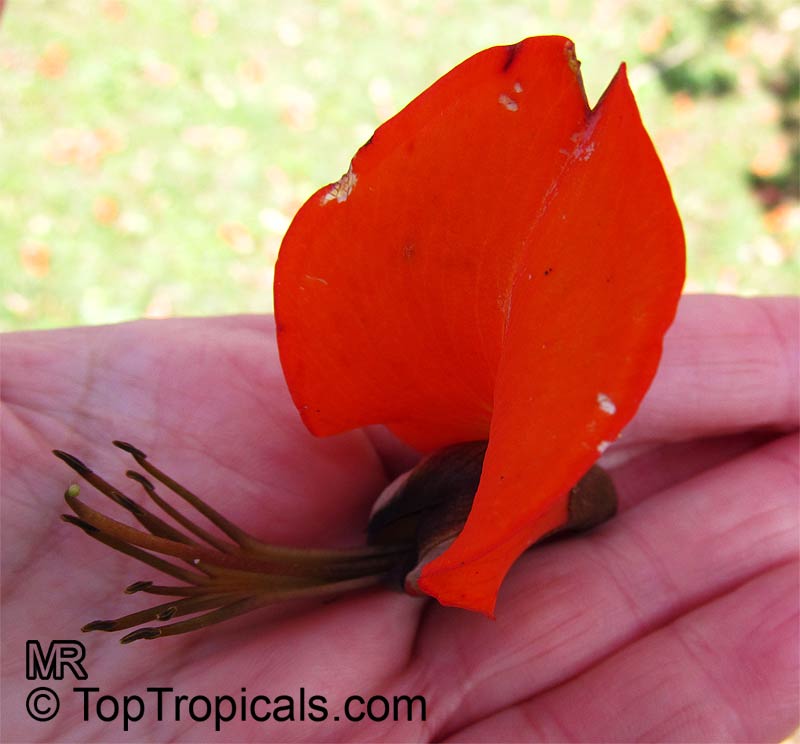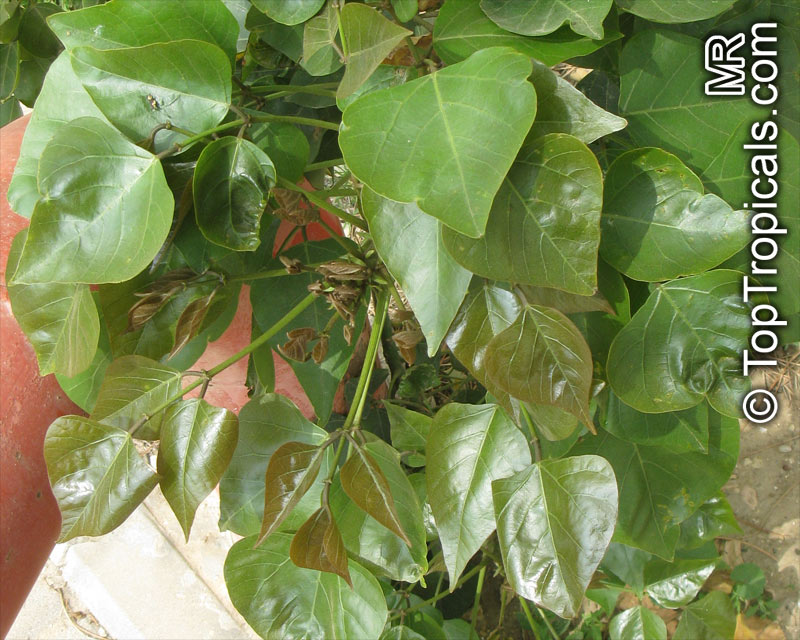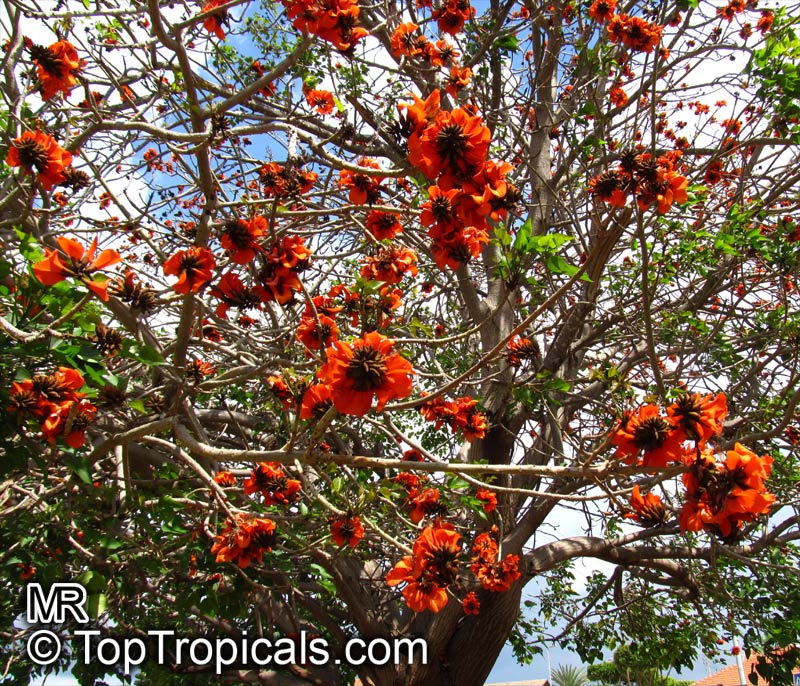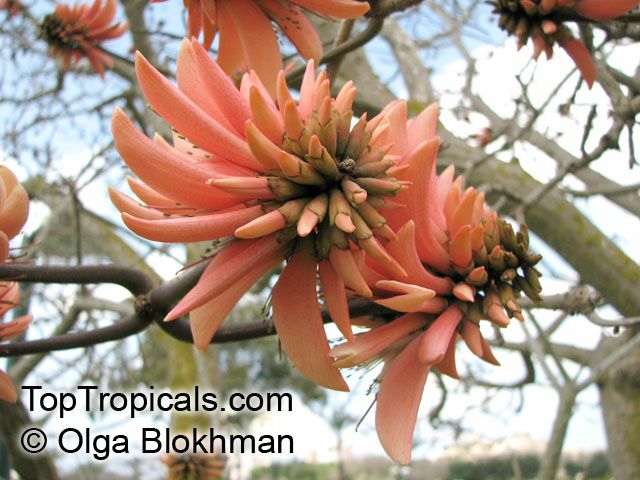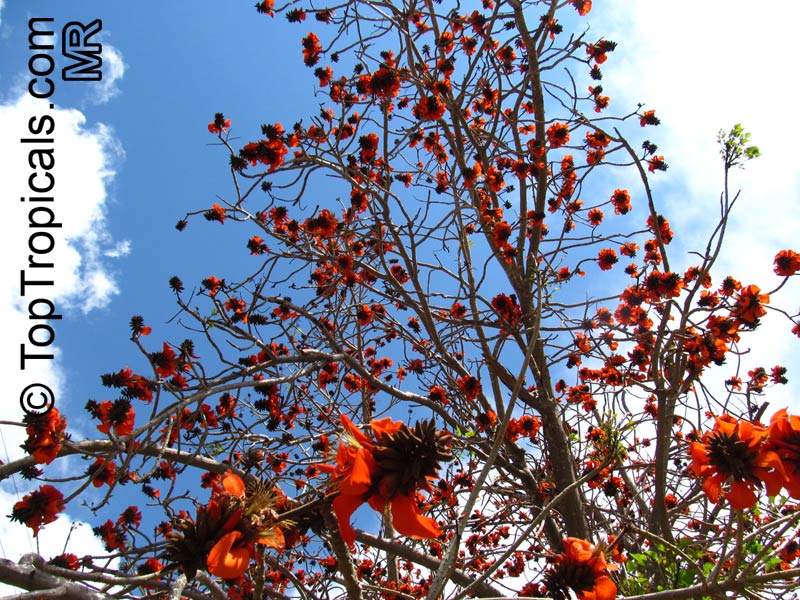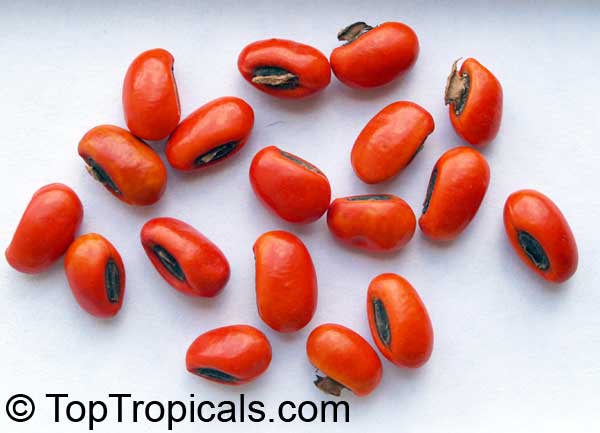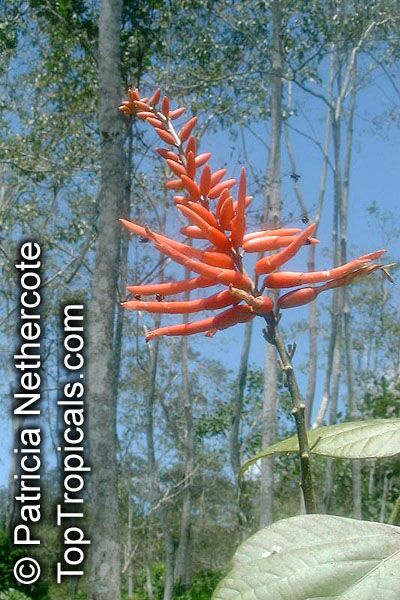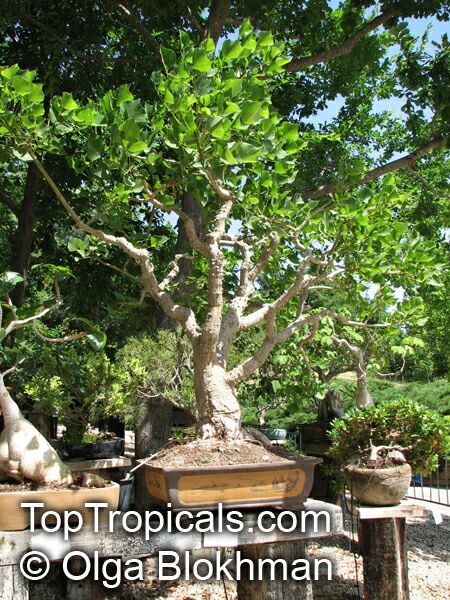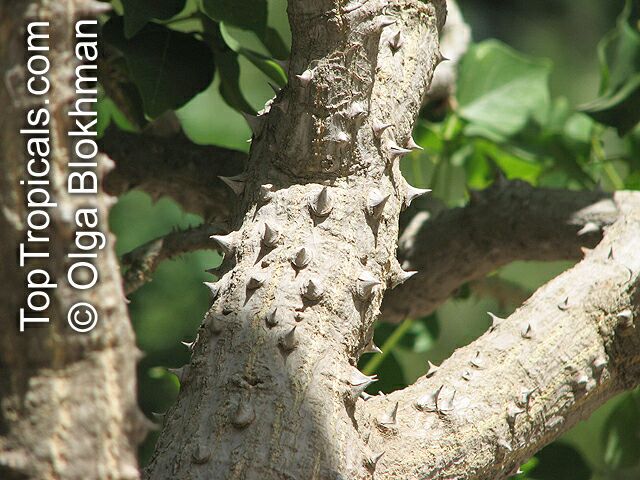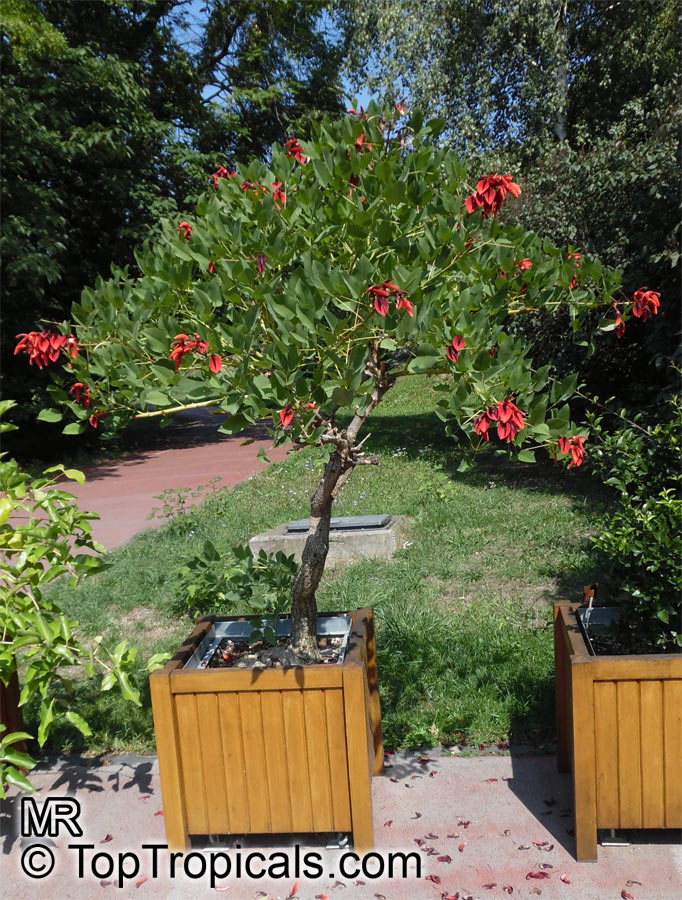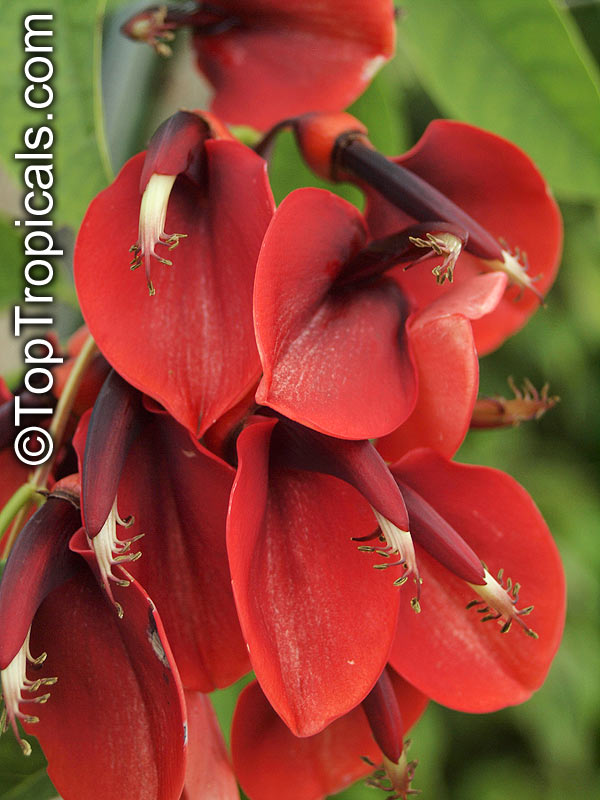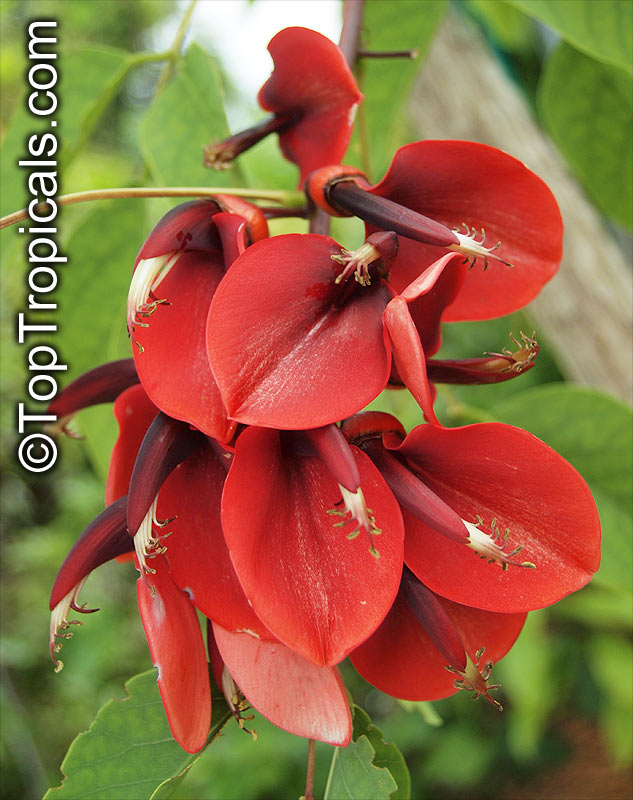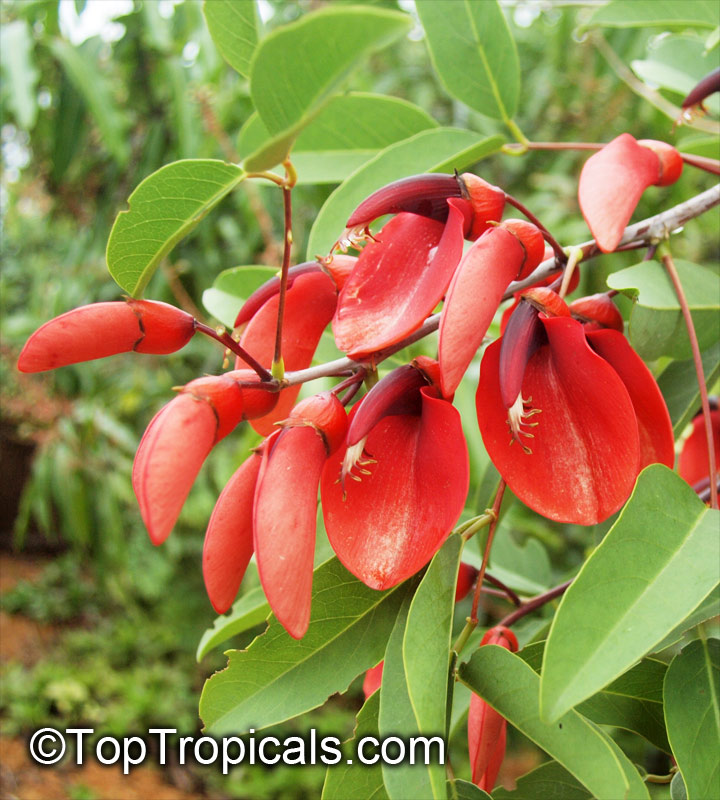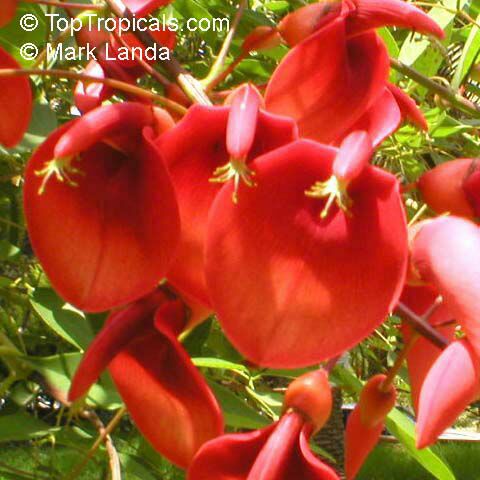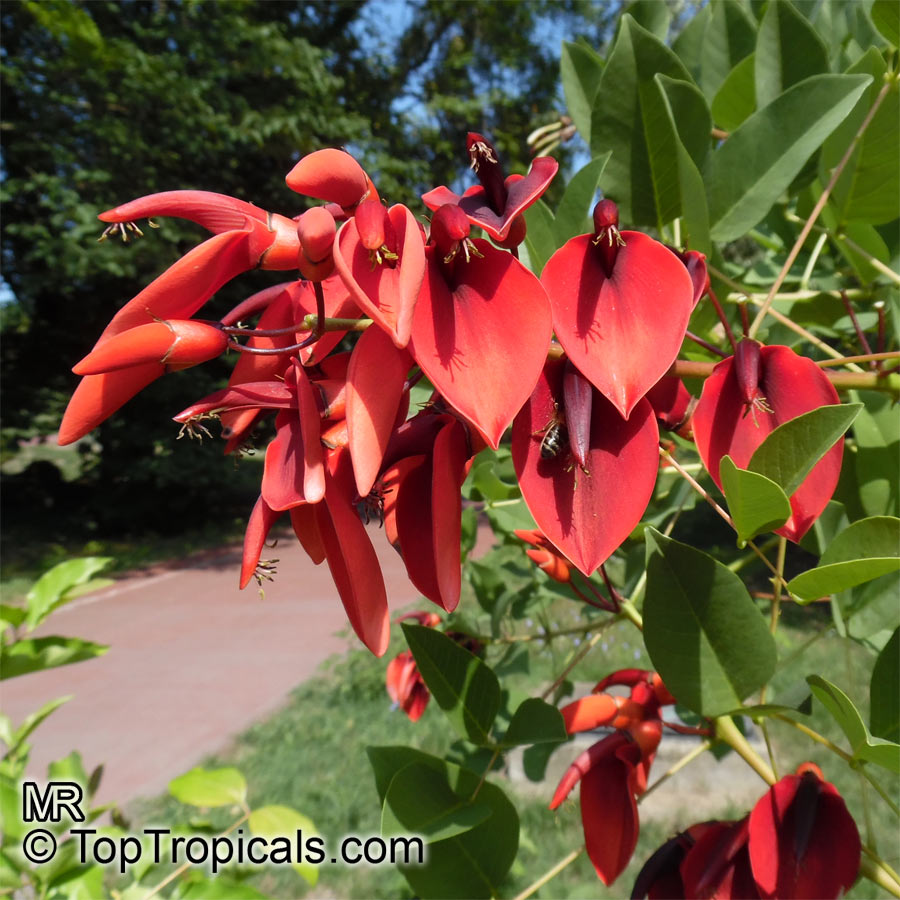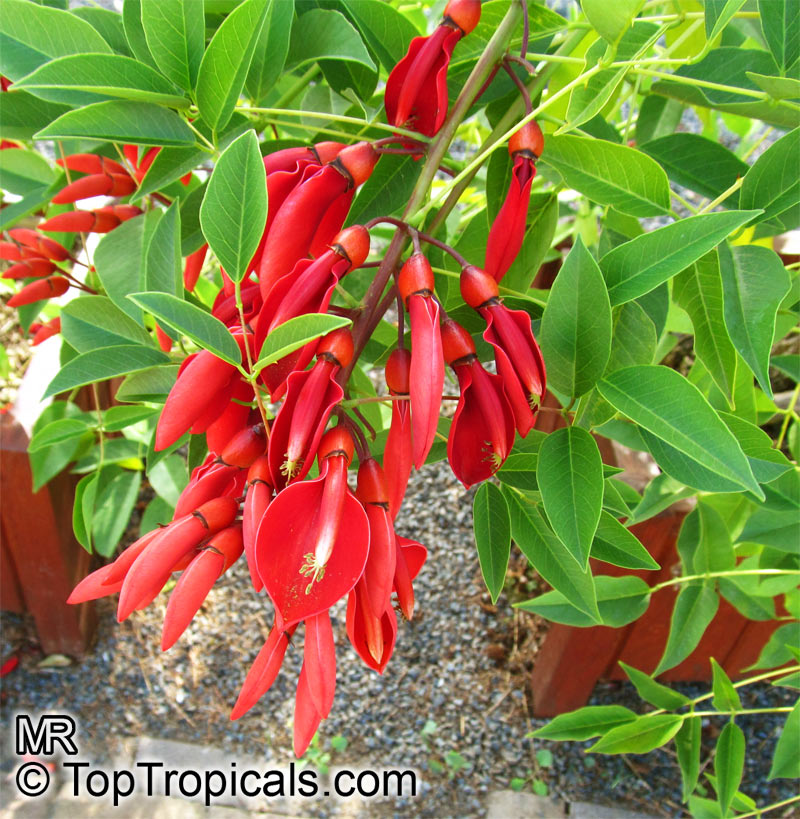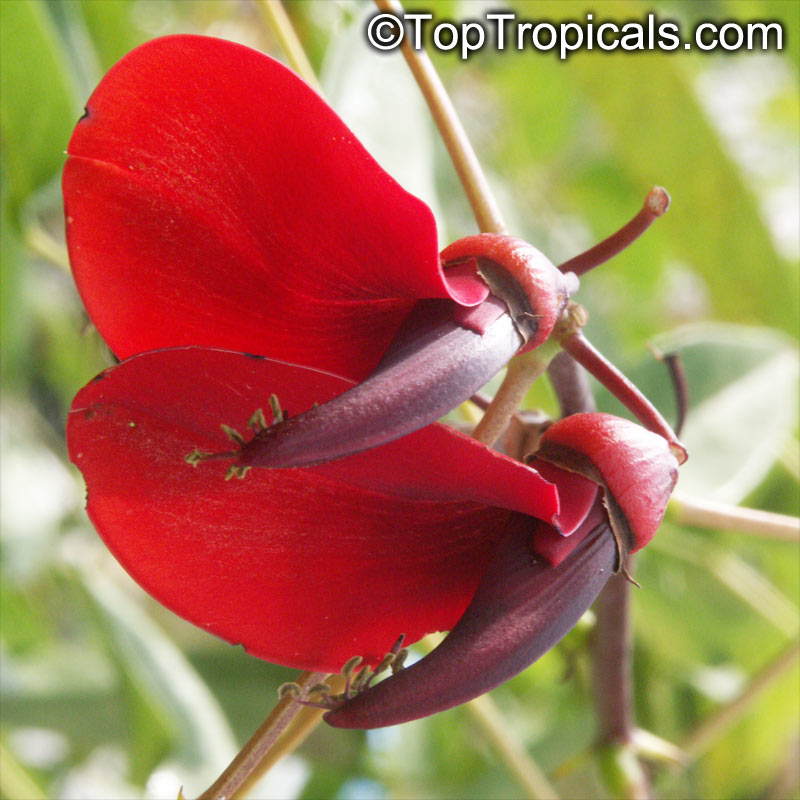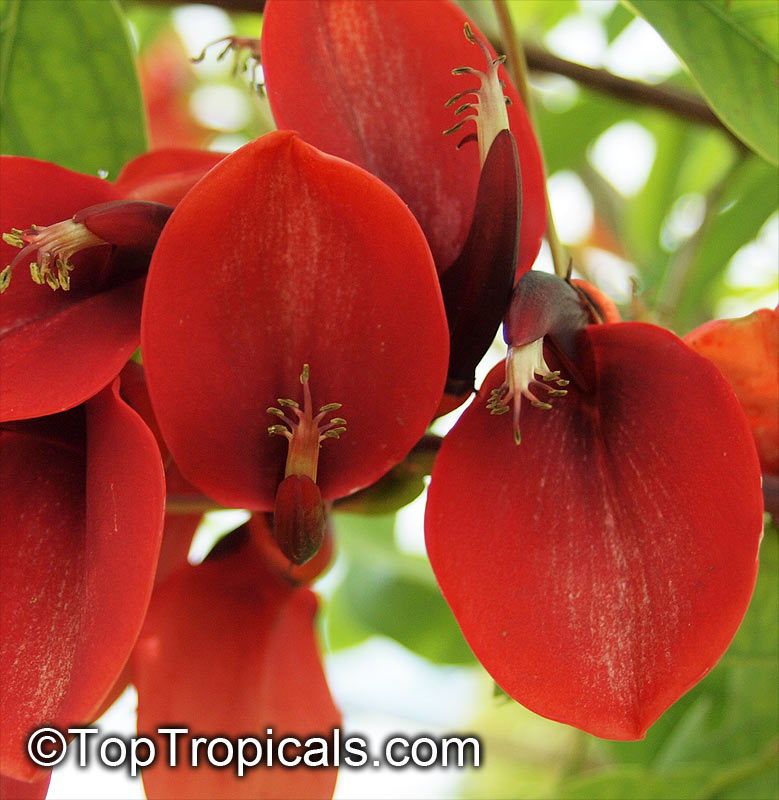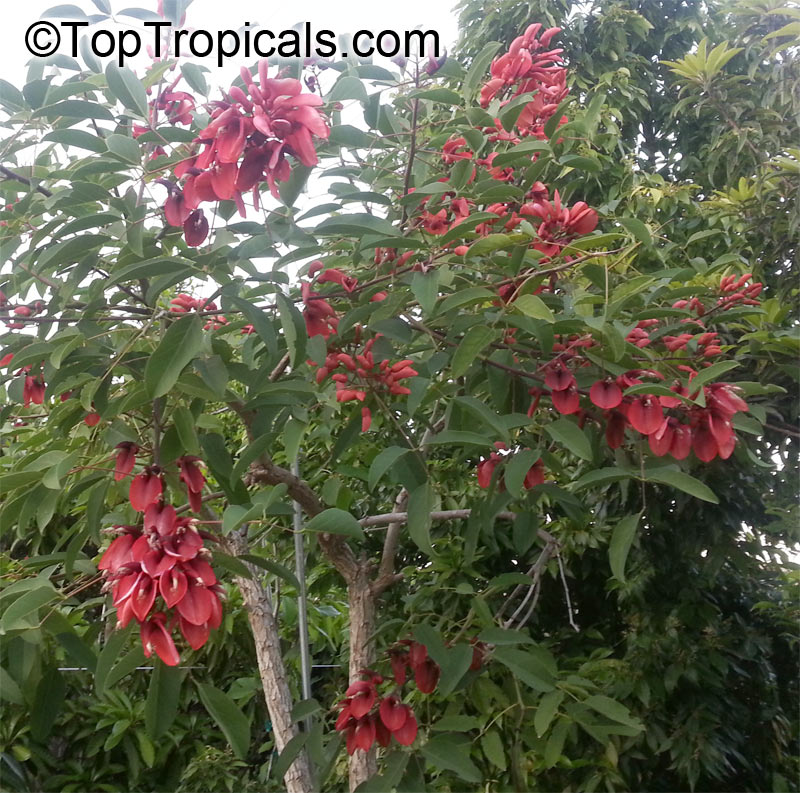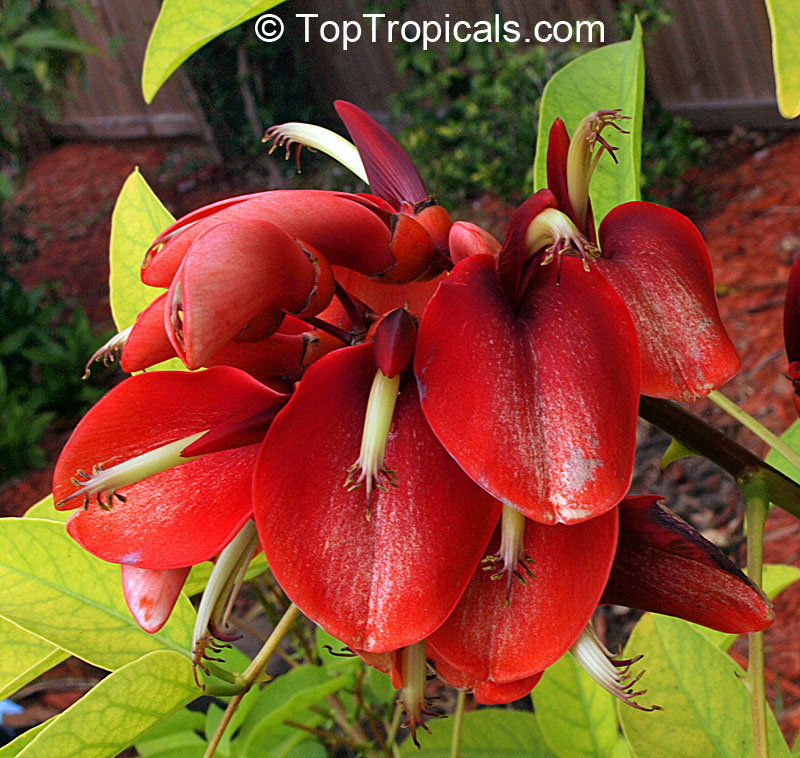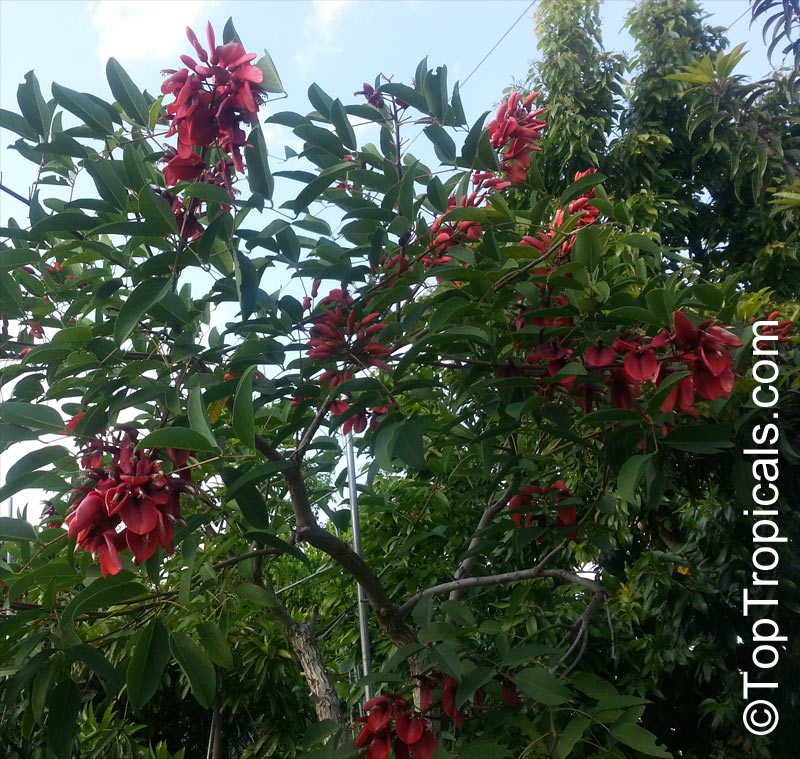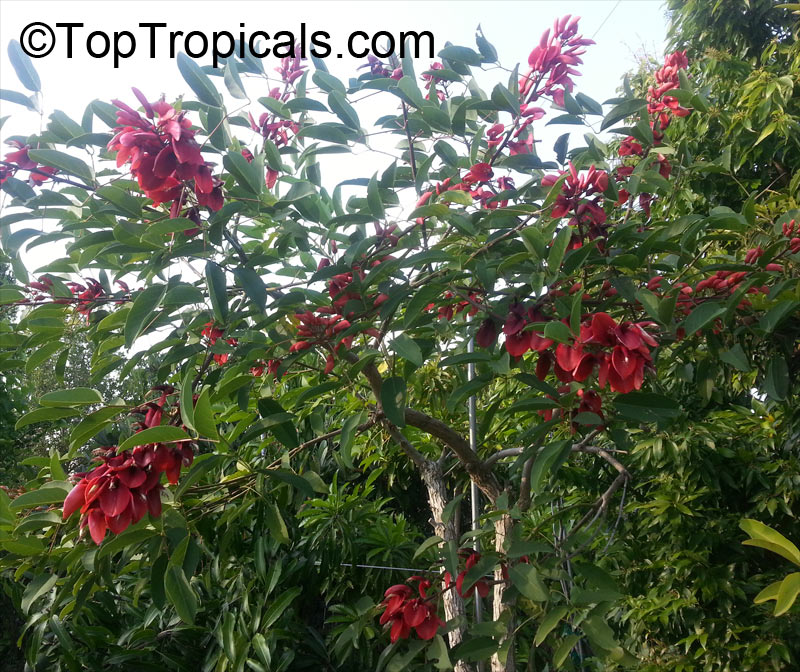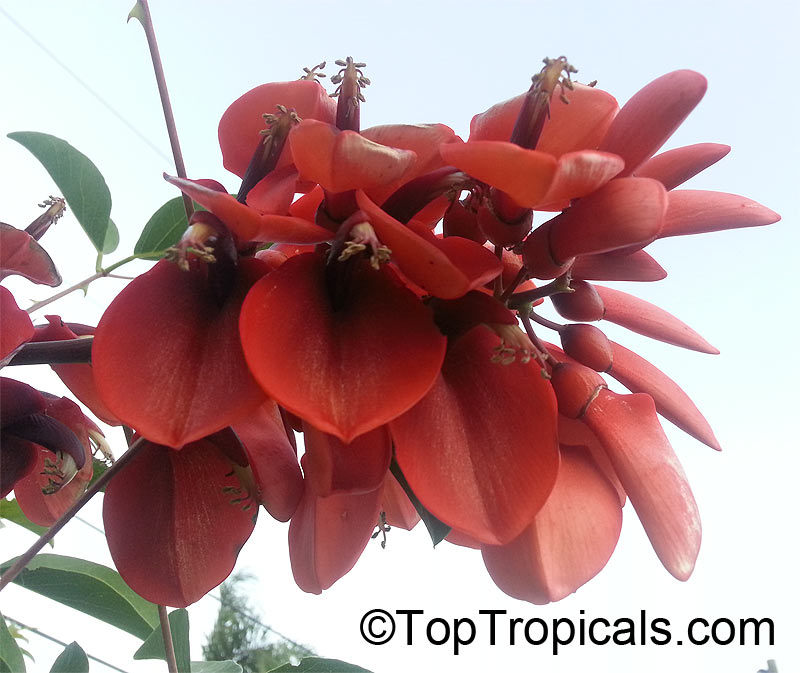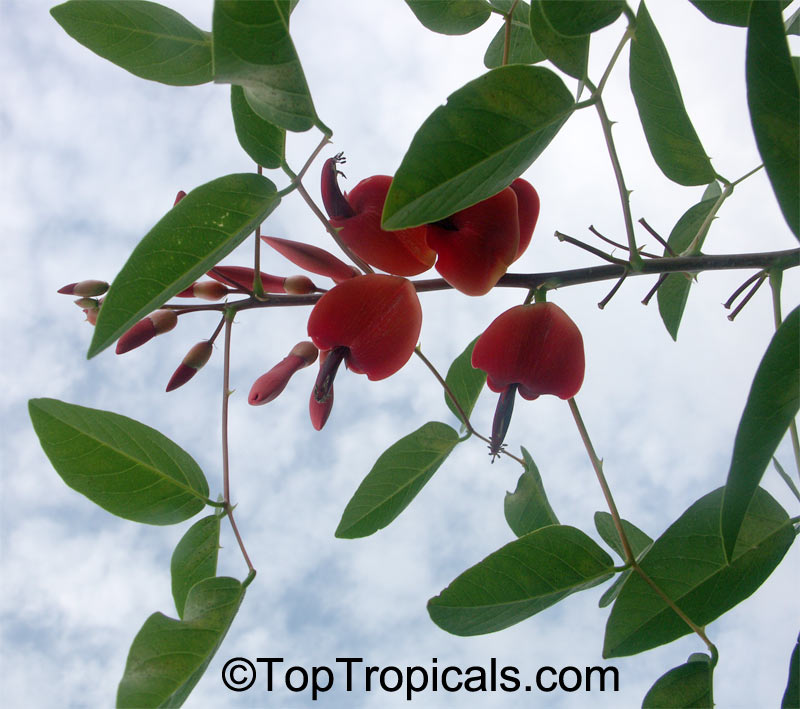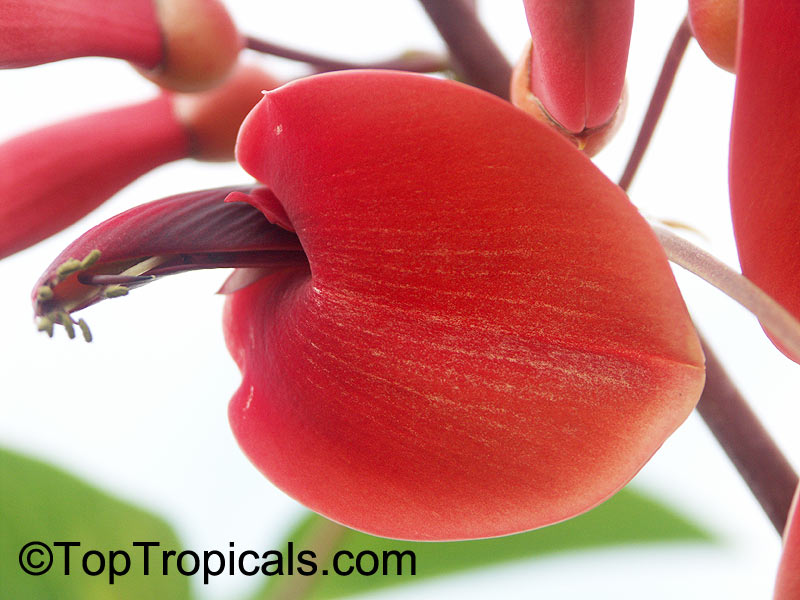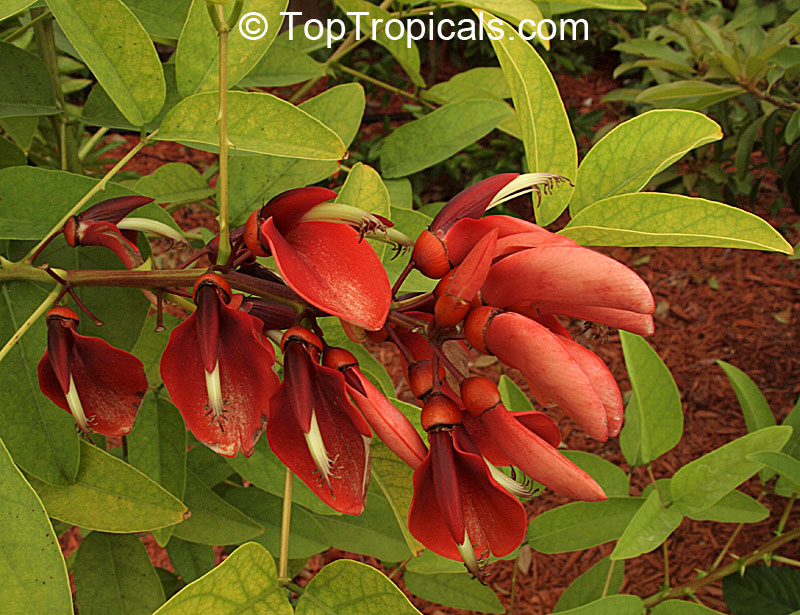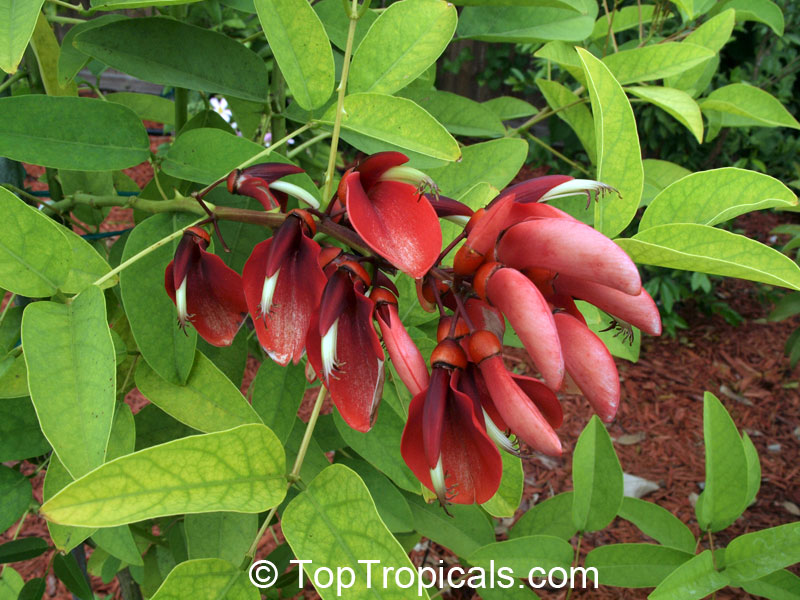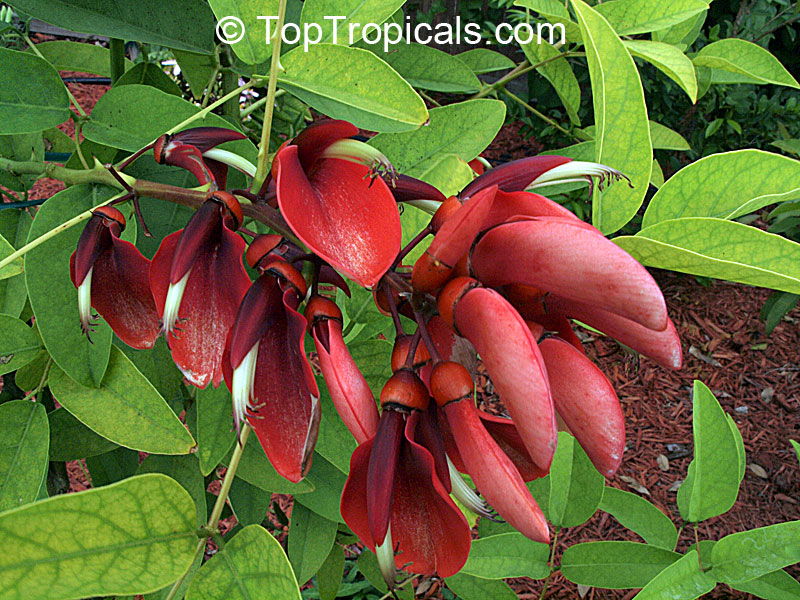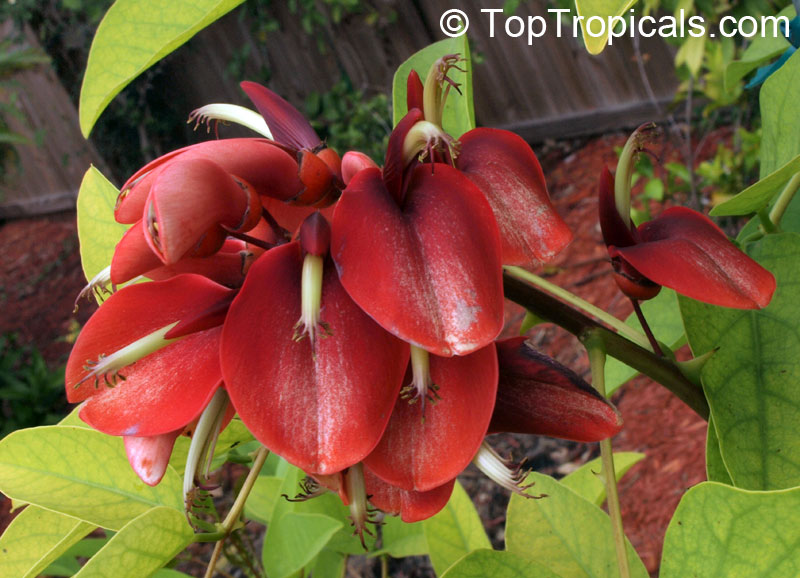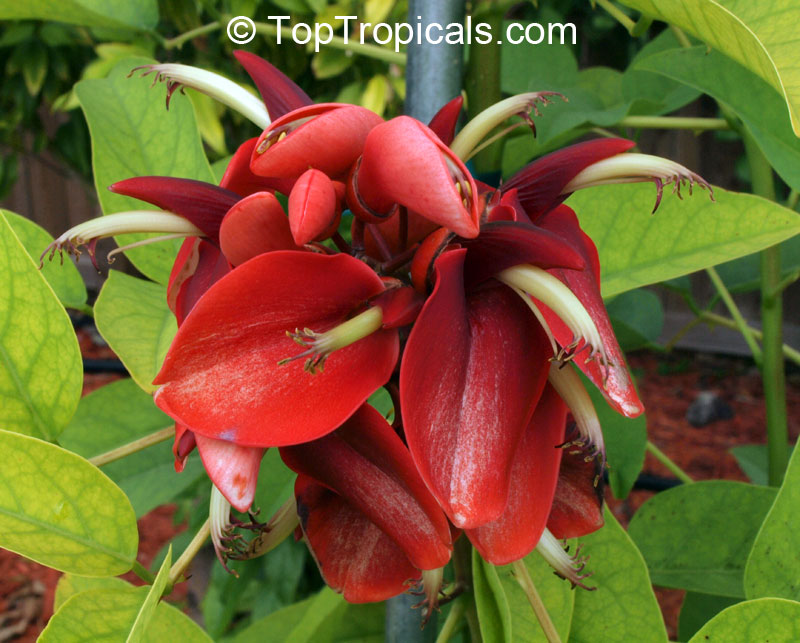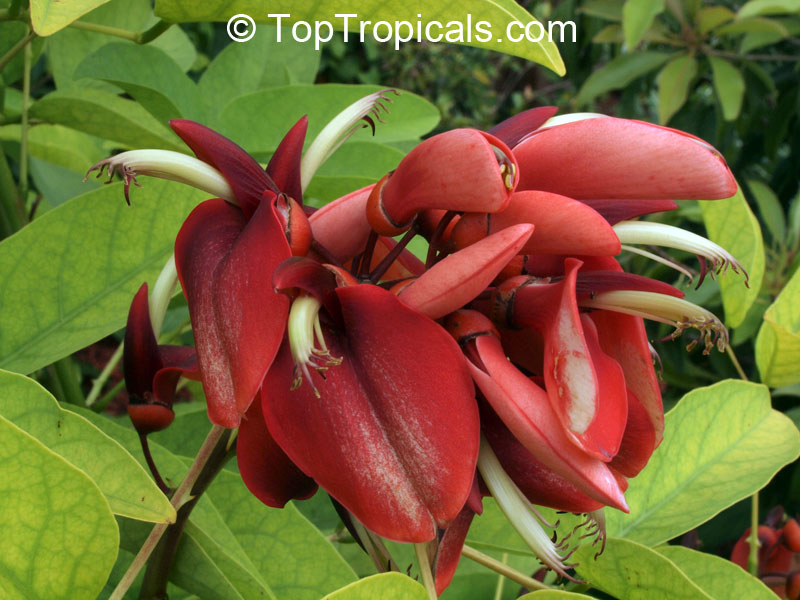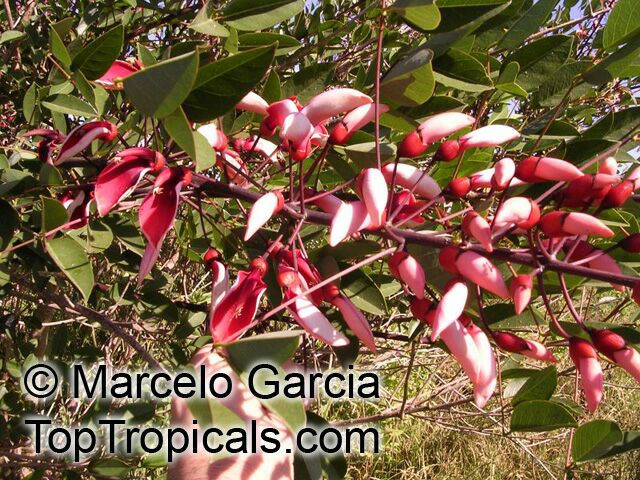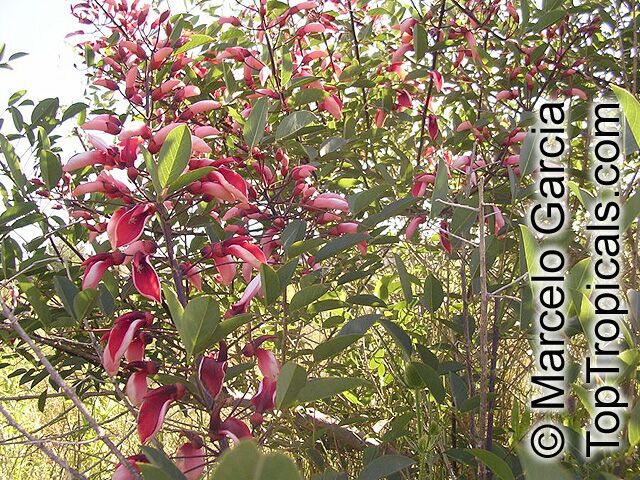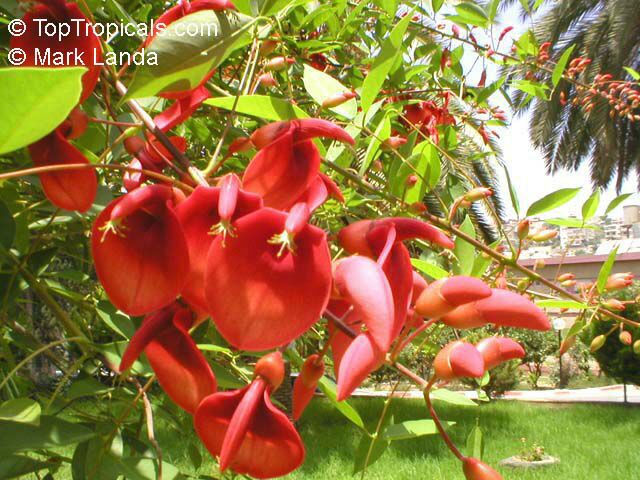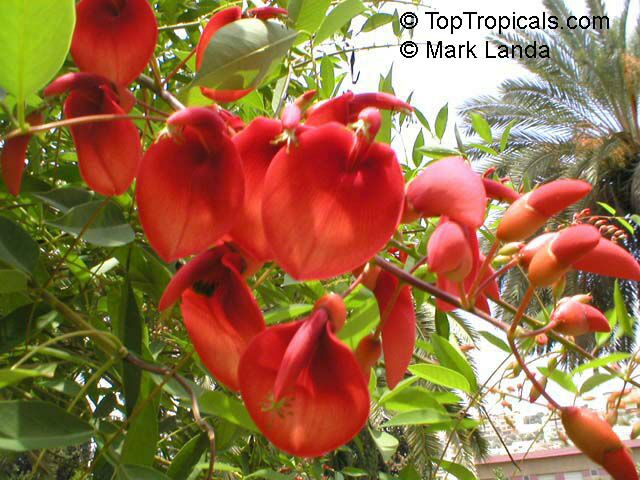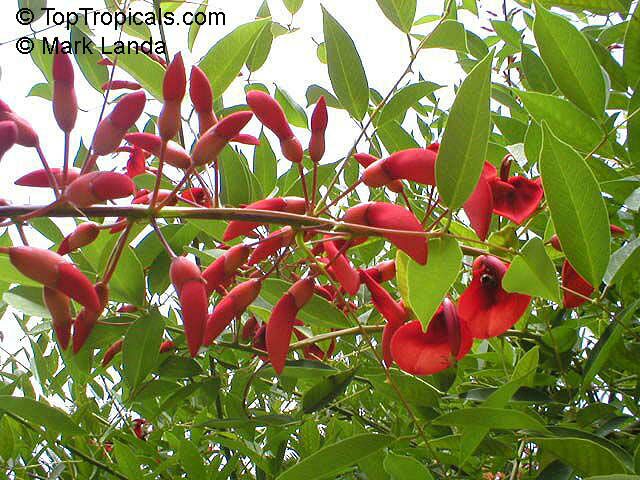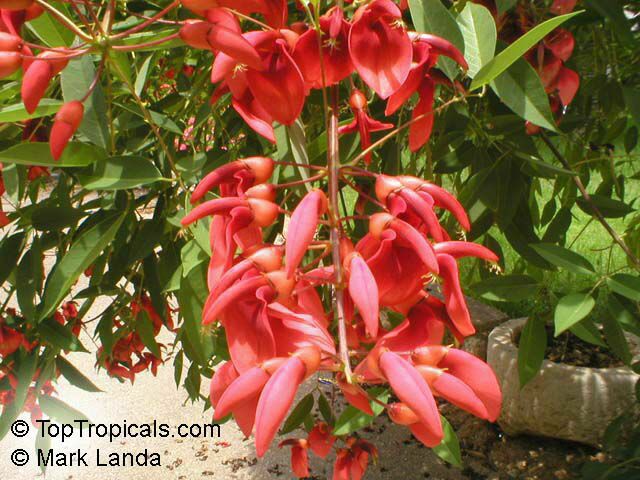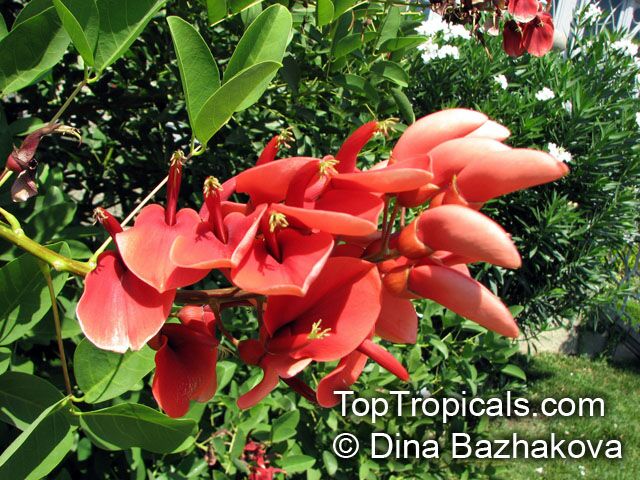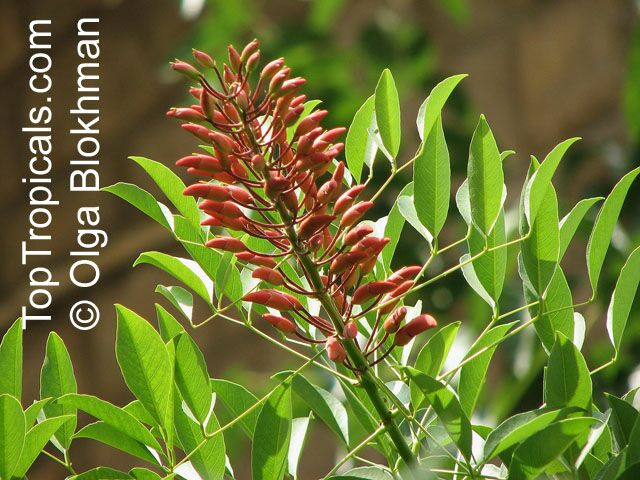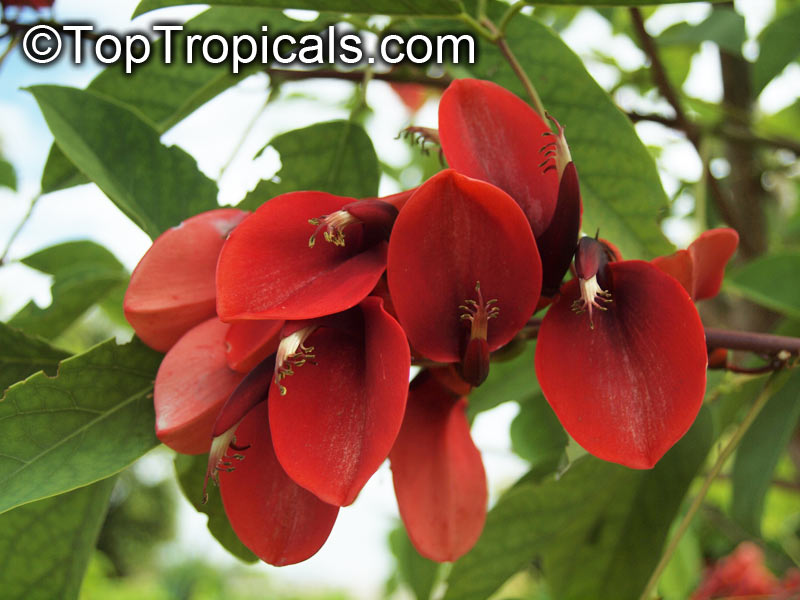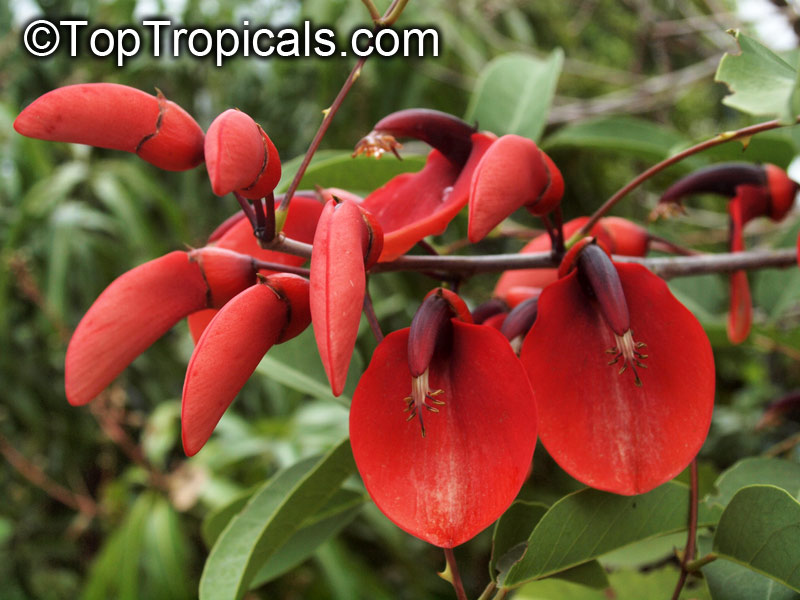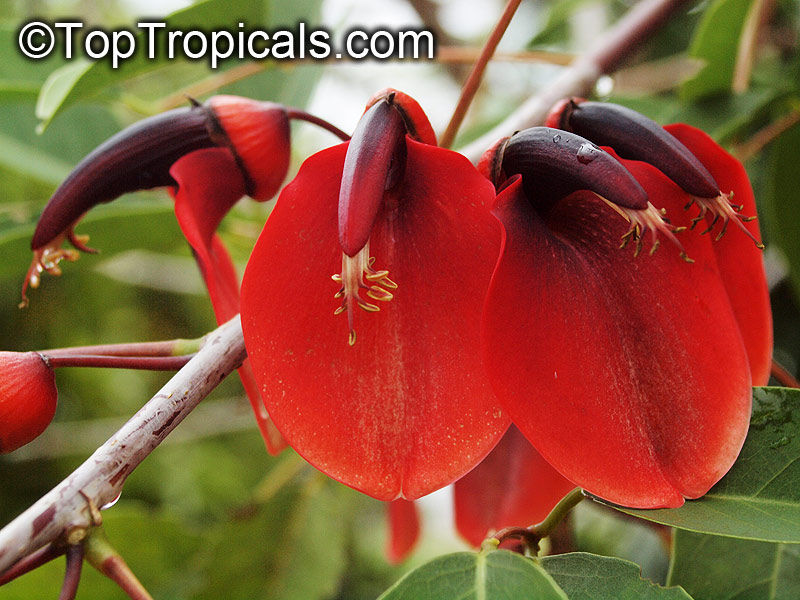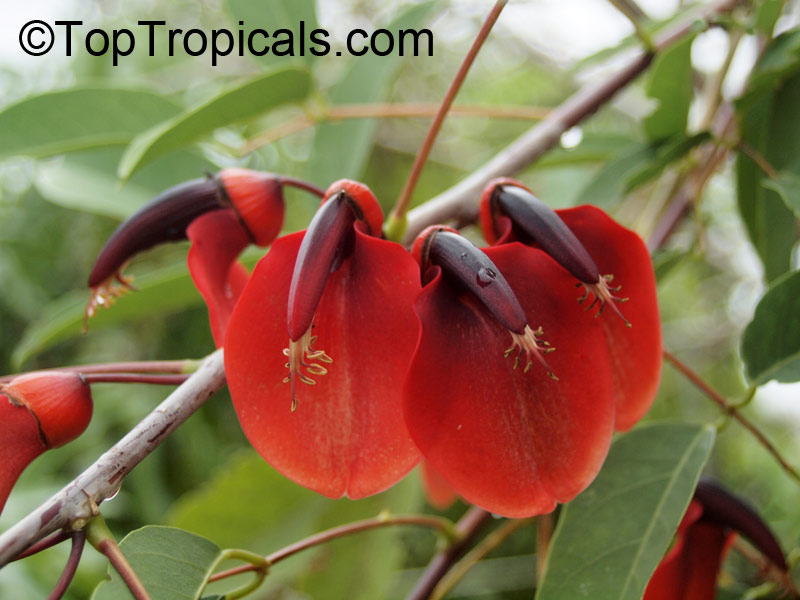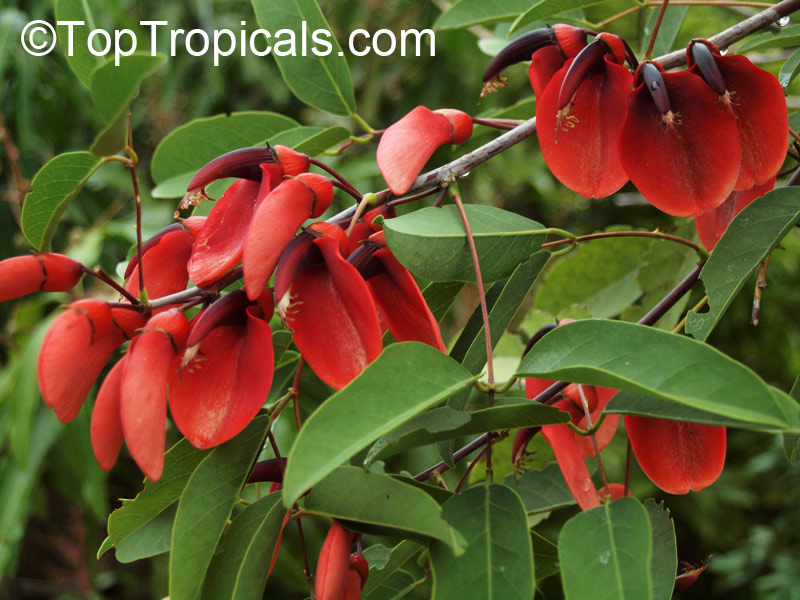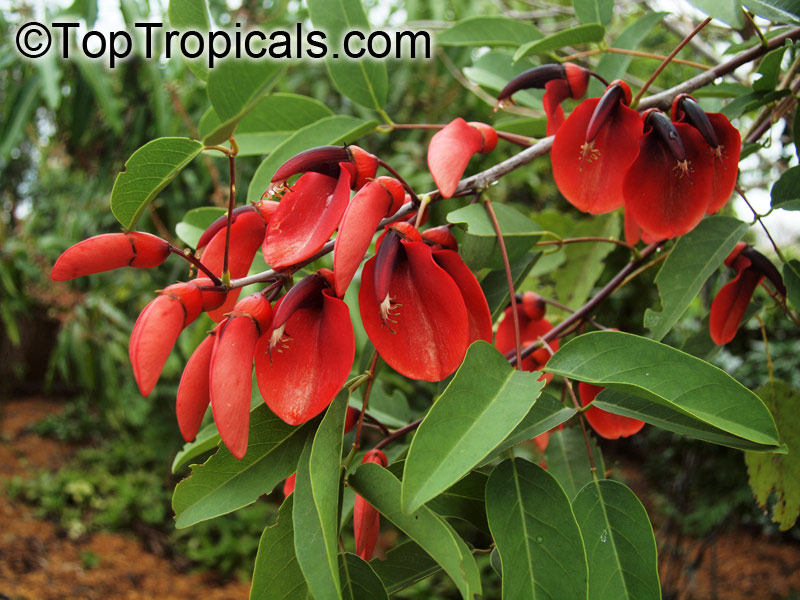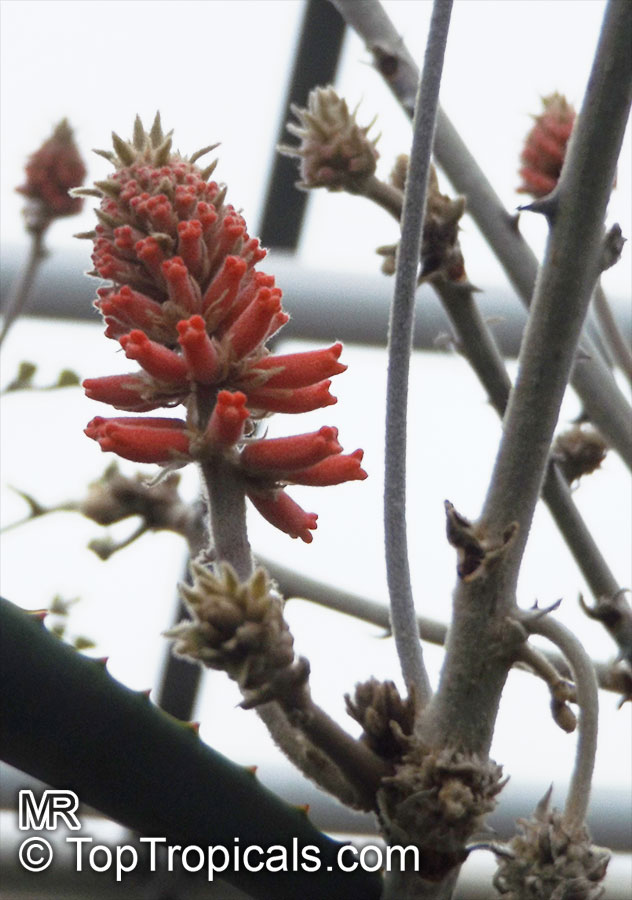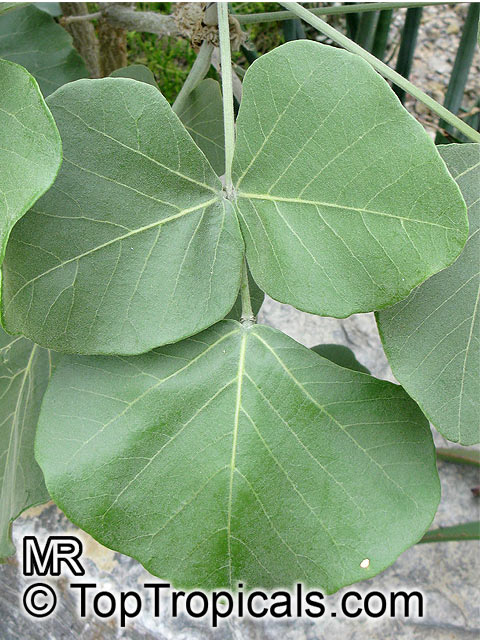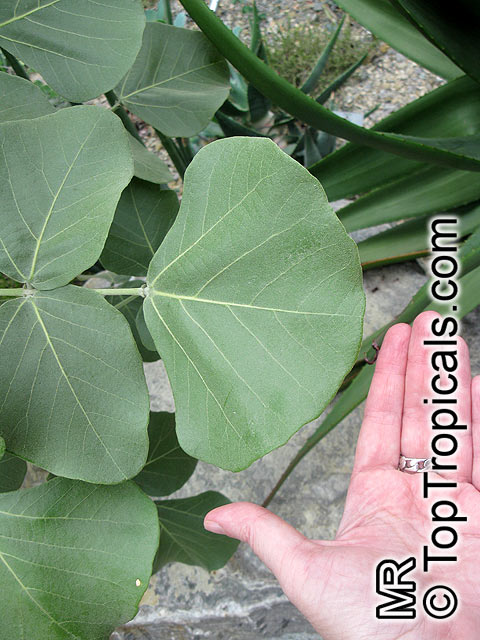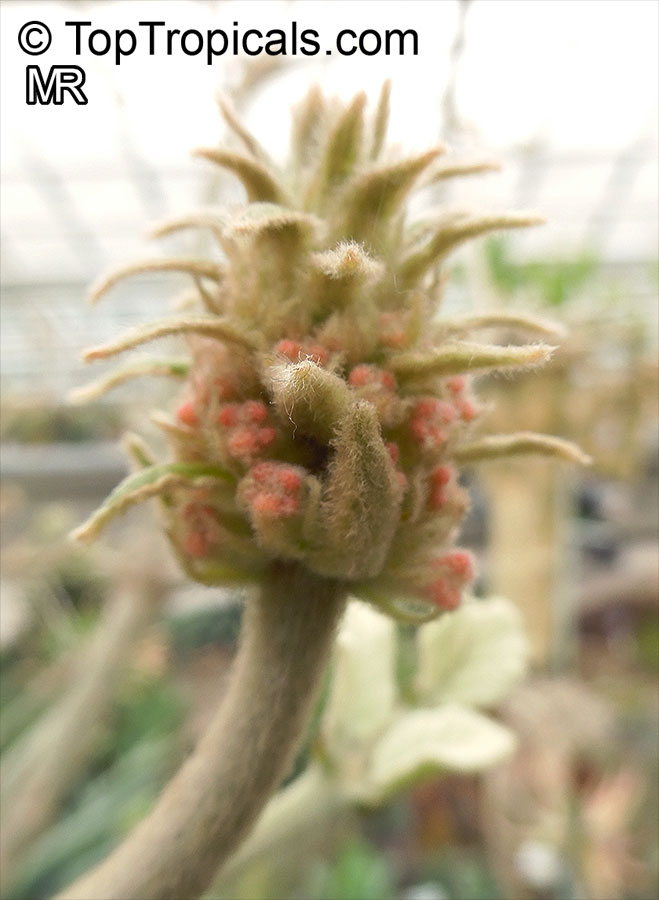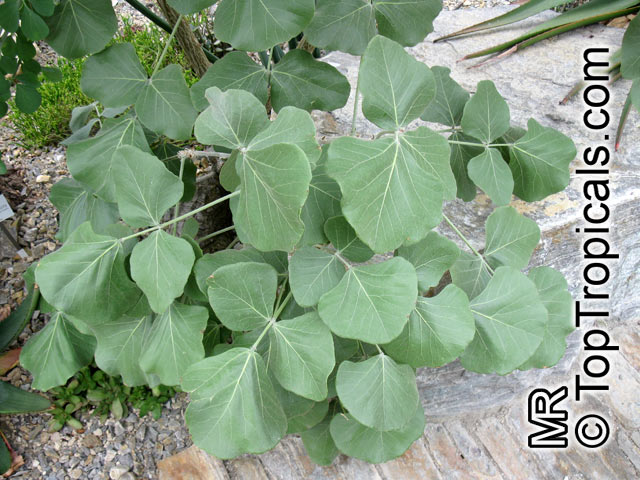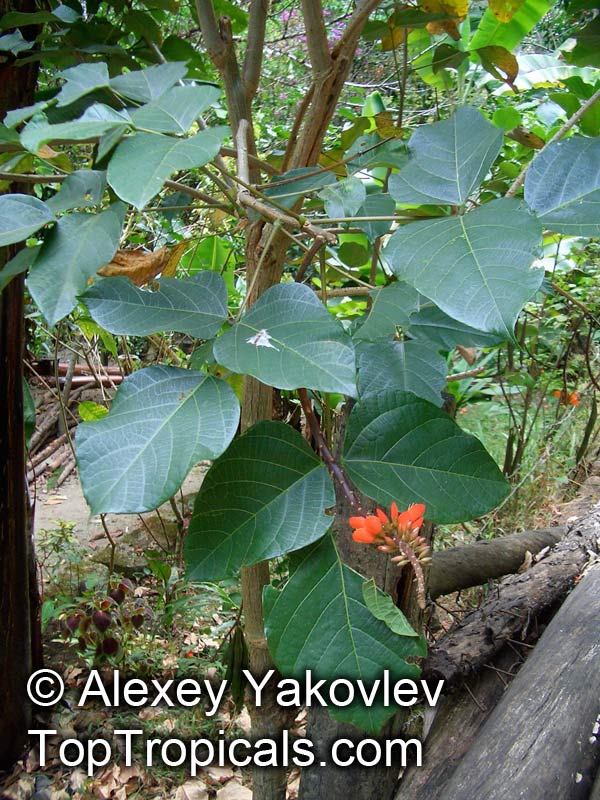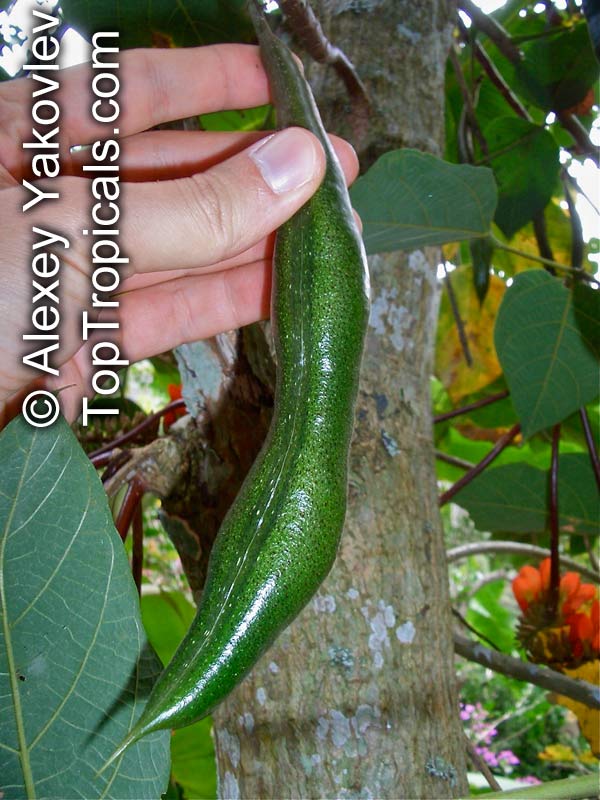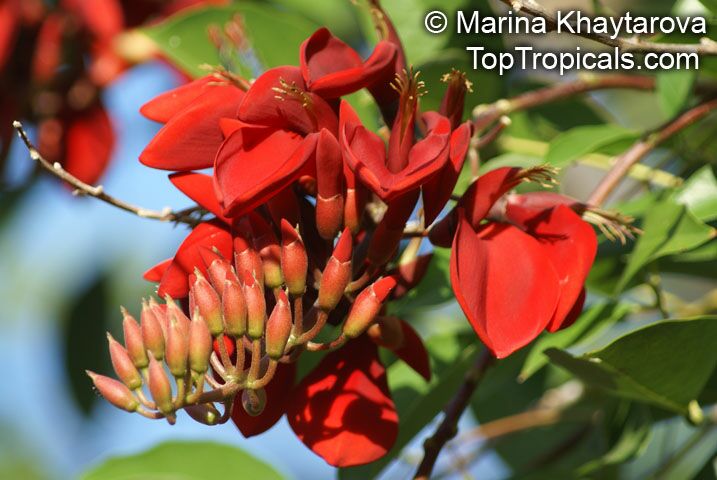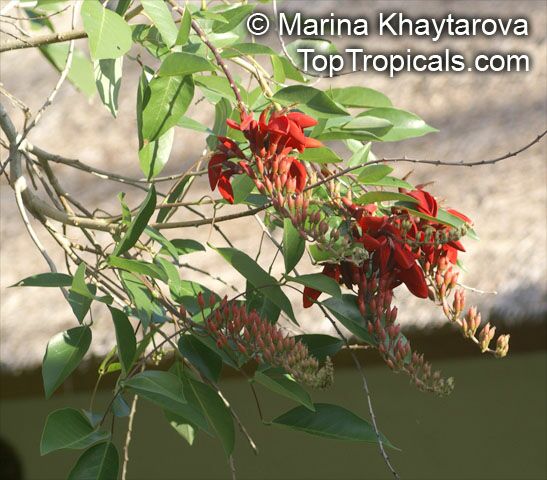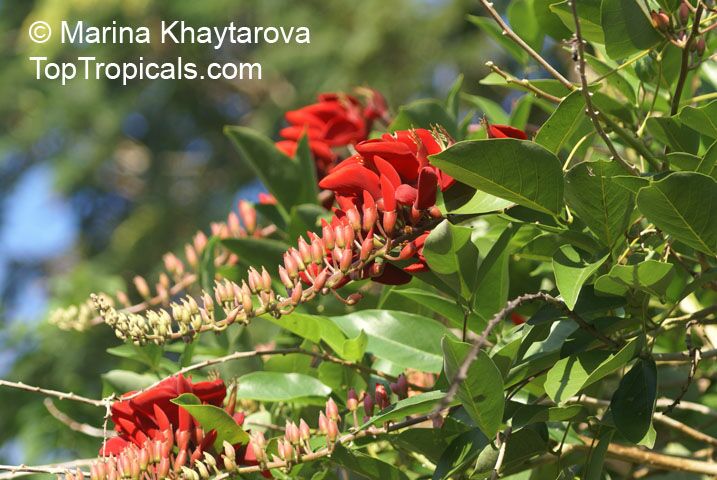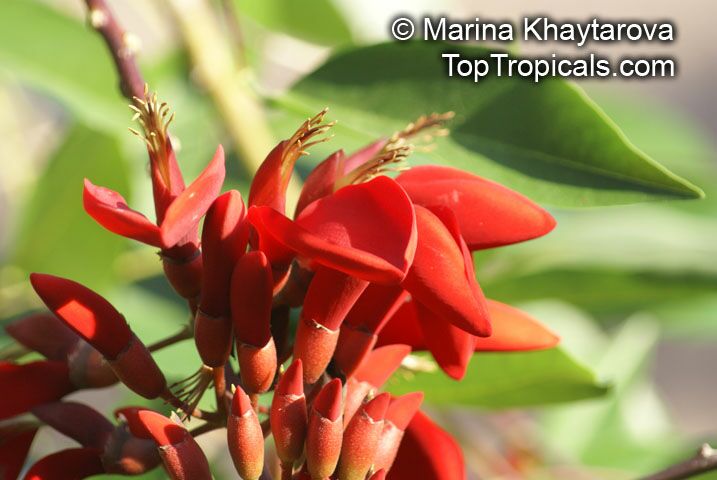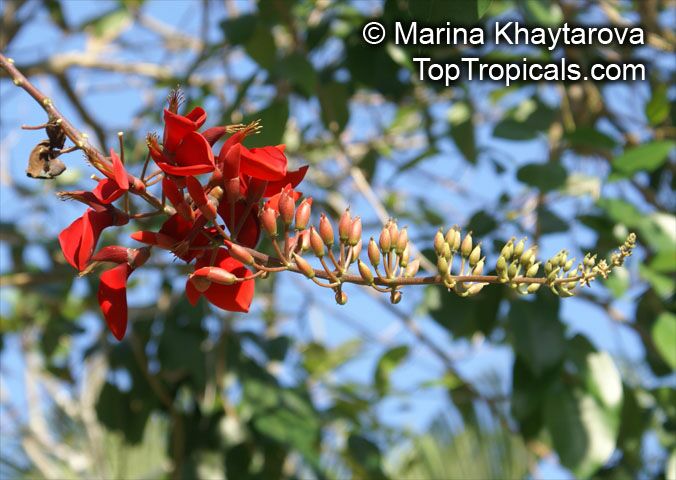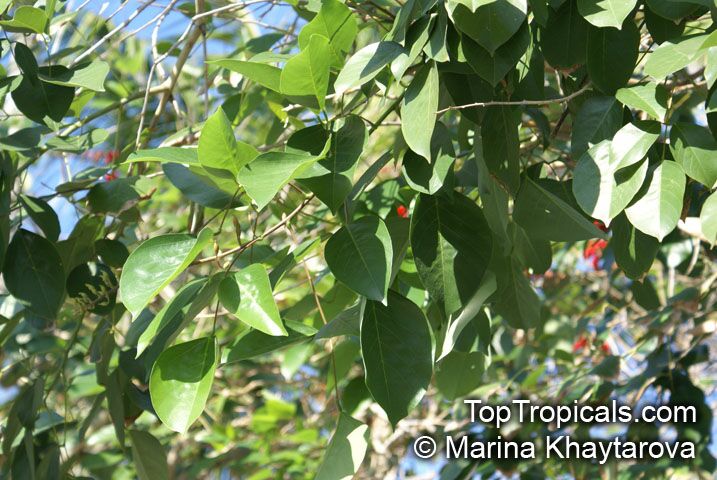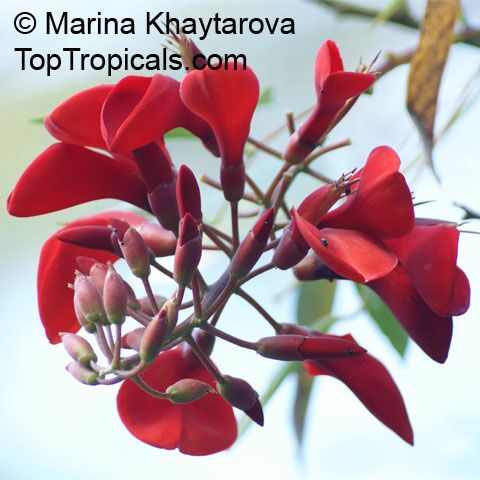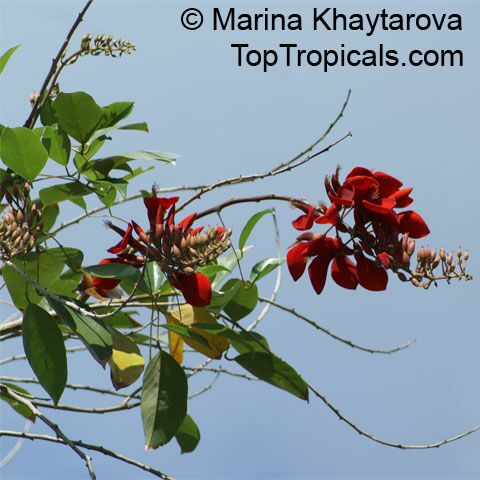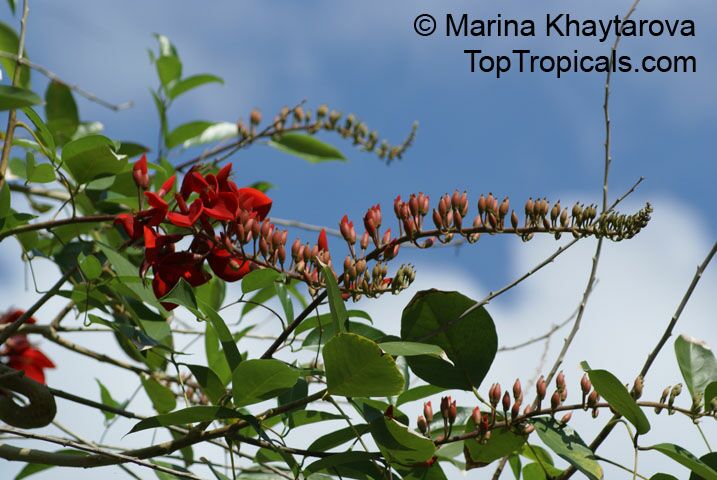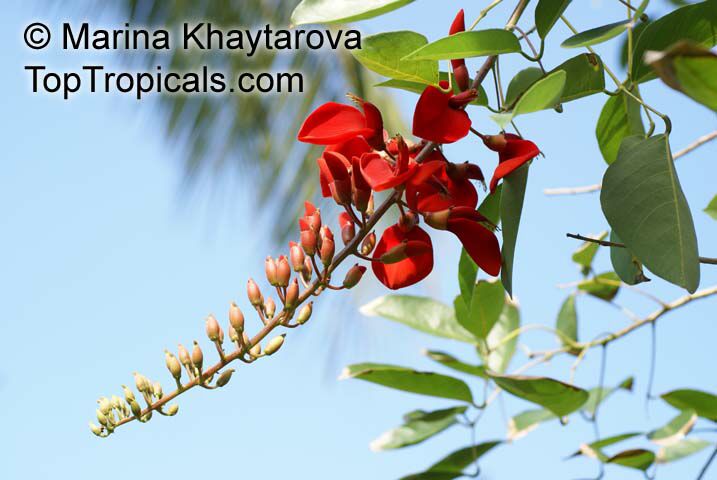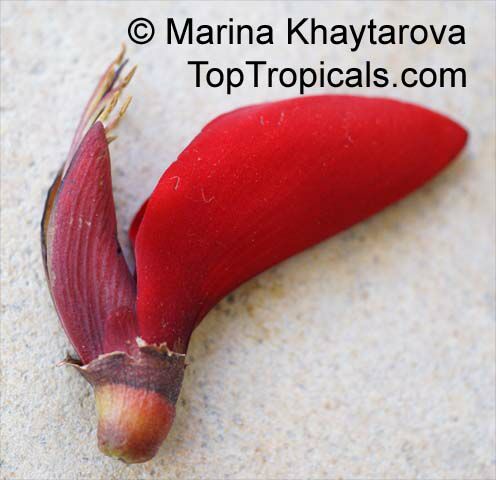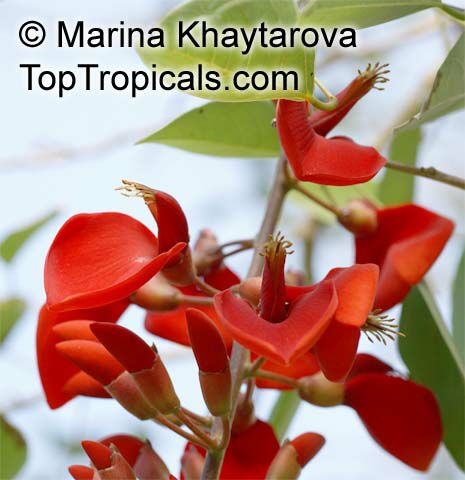Erythrina - Plant Encyclopedia Results
Top Tropicals Plant Encyclopedia
| Number of plants found: 22 | Next | 
|
Go to page: | 1 | 2 | 3 |
Botanical names: Butea monosperma, Butea frondosa, Erythrina monosperma
Common names: Flame of the Forest, Dhak, Palas, Bastard Teak, Parrot Tree
Family: Fabaceae
Subfamily: Faboideae
Origin: India, Sri Lanka










This tree has stunning flower clusters. In the habitat it can grow tall, but can be grown in container as a small specimen tree. The trunk is very interesting, it becomes twisted, follows no particular pattern, making it a conversation piece. At the base it can form a bottle-like caudex if grown in a pot. It is slow growing and attains a height of about 15-20 ft when mature at the age of about 50 years or so. The bark of Dhak is fibrous and bluish gray to light brown in color. It exudes a kind of red juice when injured. That dries into a very useful gum. The leaves are large, up to 1 ft wide and long, compound, each has three leaflets with tough texture: coriascious with the surface glabrescent above and hairy silken beneath. The leaves fall off by December and reappear during spring. When the tree is leafless, it bears flaming orange to red-colored flowers appearing in February and stay on nearly up to the end of April. The flowers form a gorgeous canopy on the upper portion of the tree, giving the appearance of a flame from a distance. The fruit of palas is a flat legume; young pods have a lot of hair a velvety cover. The mature pods hang down like peculiar legumes. This plant is useful in many ways. Its leaves are essential for various religious rituals in Hindu homes. These are also used as cheap leaf plates and cups for rural feasts. In some parts of the country these are used for wrapping tobacco to make biddies. These are further used as packing material for parcels. The cattle also eat the Dhak foliage quite greedily.The bark of Dhak yields a kind of coarse and brown colored fiber, which is used for rough cordage. Butea gum is a dried astringent juice obtained from incisions in the stem of the tree. The juice exuded by the bark hardens in to brittle ruby colored gum beads. This gum is sanctioned to be used as a substitute for the kino gum. It finds use for caulking boats as well. The Dhak flowers yield an orange dye. The seeds are used in Ayurvedic and Unani medicine for treating a number of human maladies. The Dhak tree acts as a host for lac insect and is, therefore, useful in producing natural lac. Use it as a specimen, or as a background component of the canopy. The tree loses its leaves as the flowers develop, in January - March. The plant has a good salt-tolerance, it can be used in coastal areas, but protect from direct exposure to salt spray, which will burn the leaves. See article about this plant with PICTURE GALLERY of Butea.
Botanical names: Erythrina abyssinica, Erythrina tomentosa
Common name: Coral Tree
Family: Fabaceae
Subfamily: Faboideae
Origin: Mozambique






Rare species with amazing and unique flower. An excellent plant for landscaping use.
Botanical name: Erythrina amazonica
Common name: Amazon Coral Tree
Family: Fabaceae
Subfamily: Faboideae
Origin: Tropics









One of the most impressive erythrinas, this is a very rare hybrid of hortucultural origin. It produces flowers before its new leaves or just as the leaves begin to show. The flowers are a beautiful intense crimson color with a gradient to pink and white. Petals are very long and elegant. The flowers produce abundant nectar that attracts many nectar-feeding birds and insects, which attract the insect-feeding birds as well.
Botanical name: Erythrina bidwillii
Common names: Indian Coral Tree, Bidwell's Coral Tree
Family: Fabaceae
Subfamily: Faboideae








It will remain as a large shrub in cold climates approximately 5 to 10 ft. tall, growing as a small tree if provided protection from cold temperatures. Erythrina bidwillii prefers full sun to light shade and requires moderate water. It has a thorny trunk, and many of the stems bear large spines or thorns. This Indian Coral Tree is incredibly fast-growing, and can provide an instant impact to any landscape.
The foliage and bark are very ornamental. The plant is also very tolerant of urban pollution. This plant attracts hummingbirds and butterflies and is considered deer resistant. It displays abundant clusters of red, crimson, or vinous flowers during the summer months.
It is best grown in USDA Zones 8-11. Erythrina bidwillii may be grown in a container in cold regions. It is best to keep this plant on the dry side during the winter months and should be brought indoors when temperatures in the 20s or lower are forecasted. During the winter months, the pot should be placed in a cool spot, out of direct sunlight, and be kept lightly moist until the plant is ready to begin growing in the spring. In the summer, the plant will require regular watering and fertilizing. With regular watering and fertilizing, it will produce a larger, more profuse flowers.
Botanical names: Erythrina caffra, Erythrina constantiana, Erythrina insignis
Common names: South African Coral tree, Kaffirboom
Family: Fabaceae
Subfamily: Faboideae
Origin: South Africa









Erythrina caffra is often confused with Erythrina lysistemon, the Common Coral tree. Erythrina caffra grows in the coastal and riverine fringe forests from Port Shepstone in KwaZulu-Natal to the Humansdorp District in Eastern Cape and in a pocket further north on the KwaZulu-Natal coast. It is generally taller than Erythrina lysistemon, the flowers are orange-scarlet, and a cream-flowered form is occasionally seen, and the standard petal is shorter and broader so that the stamens stick out of the flower giving it a whiskered look. In most other respects they are very similar, and were in fact regarded as the same variable species for many years and, when not in flower, are difficult to tell apart.
Botanical name: Erythrina coralloides
Common name: Naked Coral Tree
Family: Fabaceae
Subfamily: Faboideae
Origin: Mexico










Often called Naked Coral Tree or Naked Mexican Coral Tree, Erythrina coralloides is a deciduous plant with a small tree growth of 10-20ft in height. Native to Mexico and found through Central America, this tree can be used for bonsai and is especially popular in tropical and subtropical climates where it has become an invasive species.
Erythrina coralloides is a visually stunning tree that is ideal for landscapes when the bright yellow, off-white and red, crimson, vinous flowers burst in January and February. Since the flowers come out before the foliage, this tree creates a stunning addition to any landscape. The flowers also attract a variety of butterflies, hummingbirds and other pollinators while providing an excellent nectar source.
This plant prefers full sun but can also tolerate some levels of semi-shade. It is drought tolerant but prefers moderate water and easily grows in warm climates. However, Erythrina coralloides is also mature plant cold hardy down to 30s F for a short time, meaning it can thrive in USDA Zones 9-11.
When grown in colder climates, it is especially important to provide the tree with adequate protection from strong winds. When planted in a small pot, it is a good idea to keep the pot indoors during winter months and the plant should be taken care of throughout this period with adequate watering and pests and disease control. To preserve the bonsai shape and encourage the desired branch structure, it is best to prune the tree in the summer when temperatures are more moderate.
It is important to note that the seed of this plant, Erythrina coralloides, is poisonous if ingested. Therefore, it should be handled with caution specifically around small children, pets and livestock.
Botanical names: Erythrina crista-galli, Erythrina laurifolia
Common names: Cry Baby Tree, Cockspur Coral Tree, Cock's Comb Coral Tree
Family: Fabaceae
Subfamily: Faboideae
Origin: South America






The Erythrina crista galli is one of the hardiest and most attractive trees in the genus. It can tolerate temperatures as low as the mid twenties and returns from colder temperatures through root runners. Growing as a robust bush and often reaching up to twenty feet high and wide, this small tree has a rapid growth cycle with it maturing to its full size in just a few years. Its dense, rounded habit and heavily thorned branches are covered in large, vibrant red and Crimson flowers during the spring and attract butterflies and hummingbirds.
This tree is highly tolerant to salt, making it ideal for coastal, seaside and other gardens in climates with full sun and which fall under the USDA hardiness zones 9-11. When gardening in colder regions, it should be grown in a container and grown in a warm and well-drained location with an all-purpose potting mix. To keep the tree healthy and promote flower production, the pot should be changed every 2-3 years and supplemented with organic compost fertilizer annually. An extra bi-monthly fertilization may be necessary to ensure larger growth.
Botanical name: Erythrina decora
Common name: Namib Coral Tree
Family: Fabaceae
Subfamily: Faboideae
Origin: South Africa





Botanical name: Erythrina edulis
Common name: Chachafruto
Family: Fabaceae
Subfamily: Faboideae
Origin: South America







Botanical names: Erythrina fusca, Erythrina glauca
Common names: Cape Kaffirboom, Gallito, Coral bean, Bois Immortelle
Family: Fabaceae
Subfamily: Faboideae








Leaves are alternate, compound, with three leaflets, and the base of the petiole is swollen and cylindrical. Young leaves are eaten. Flowers are large, orange, and have a claw-like shape.
| Next |  |
Use link to repeat this search:
https://toptropicals.com/cgi-bin/garden_catalog/cat.cgi?find=Erythrina&search_op=and&keyword_op=and&language=e&number=10
&no_change_lang=1&user=tt&sale=1&first=0
